The Samsung QN95D immediately made a great impression on us. Right from the start, we felt that the Tizen system is intuitive and quick. The fast access to streaming applications such as PrimeVideo, Netflix, and MAX, as well as the ability to integrate with the SmartThings ecosystem, makes using the television simply convenient. The solar remote is a clever solution – eco-friendly and practical, as it allows control of other devices, such as a decoder (e.g. Canal+) or soundbar. While watching films and series, we quickly noticed how much of a difference the MiniLED technology makes. Thanks to the precisely functioning backlight zones, the picture gained incredible depth - which was confirmed by our contrast tests. The blacks are truly deep, and bright scenes using HDR stand out with excellent detail despite the lack of Dolby Vision. Additionally, the high brightness combined with the anti-reflective coating allows for comfortable viewing even in a sunlit room. When we played on this television, we immediately appreciated the low input lag and the fluidity of the image. The 144 Hz panel and support for HDMI 2.1 guaranteed dynamic and responsive gameplay, regardless of the game. All these features made every gaming session pure pleasure, especially in dynamic titles where precision and lack of delays matter. In terms of design - which is worth mentioning for this television - the QN95D simply looks great. The slim housing, solid central stand, and Ambient Mode function, which allows the screen to blend into the room's decor, give it an elegant touch. The included camera is an interesting addition that can be useful during video calls or when using interactive applications – like personal training through the Daily+ tab. However, for such, let’s be honest, an expensive piece of equipment, there are a few downsides. The lack of a recording function and support for sound in DTS:X format may be a problem for users seeking this feature. Nevertheless, the Samsung QN95D is a television that combines exceptional picture quality, functionality, and elegant design. The MiniLED backlighting makes a real difference here, especially if we care about deep blacks, high contrast, and excellent brightness. This is a device that will perform well during movie screenings, dynamic gaming, and everyday television watching.
- Matching (Score)
- Our verdict
- TV appearance
- Where to buy
- Contrast and black detail
- HDR effect quality
- Factory color reproduction
- Color reproduction after calibration
- Smoothness of tonal transitions
- Image scaling and smoothness of tonal transitions
- Blur and motion smoothness
- Console compatibility and gaming features
- Input lag
- Compatibility with PC
- Viewing angles
- TV efficiency during daytime
- Details about the matrix
- TV features
- Apps
- Playing files from USB
- Sound
Samsung Neo QLED QN95D vs Samsung QN900F
Direct compare
Neo QLED / QN95
NeoQLED 8K / QN900F

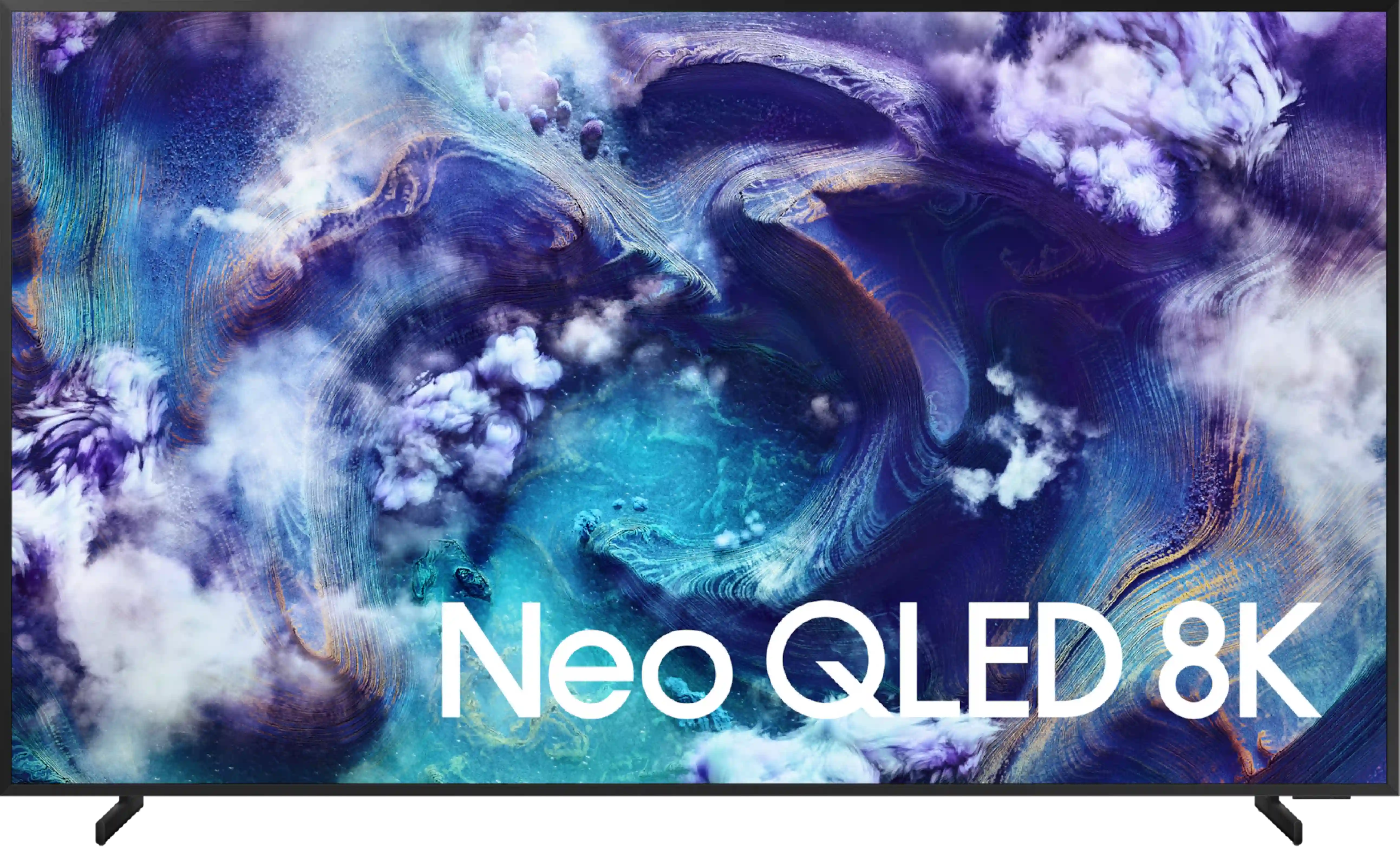
Panel type: LCD VA (wide viewing angle)
Resolution: 3840x2160
System: Tizen
Model year: 2024
Complete the survey to find out the result

Panel type: LCD VA
Resolution: 3840x2160
System: Tizen
Model year: 2025
Complete the survey to find out the result

Overall rating
7.8
7.7
Movies and series in UHD quality
8.0
7.3
Classic TV, YouTube
8.1
7.3
Sports broadcasts (TV and apps)
7.7
7.4
Gaming on console
9.2
8.8
TV as a computer monitor
8.6
8.4
Watching in bright light
6.5
7.1
Utility functions
6.7
7.2
Apps
9.1
8.7
Sound quality
7.0
8.2
Complete the survey to find out what fits your preferences
Advantages
Excellent brightness - great for HDR content
Very good contrast
Wonderful choice for gamers (HDMI 2.1 4K@144Hz, low input lag)
Wide viewing angles - unusual for this type of panel
Modern design
Camera included
Good black
Very high brightness - up to 2000 nits in HDR
Great motion smoothness - 4k@165hz with low motion blur
Many features for gamers: VRR, ALLM, Game-bar, low input lag
Decent viewing angles
High usability efficiency in difficult lighting conditions: Matte screen + high brightness
Pleasant and very fast operating system: Tizen
Pleasant sound from built-in speakers
Disadvantages
No recording support
No DTS format support - may pose a problem for Blu-ray users
The algorithms for local dimming could have been better refined.
There is no recording support from the built-in tuners.
No DTS:X (home cinema).
No HGiG*
*This is probably an update error and we are keeping track of the matter closely.
Our verdict
The Samsung QN900F is a television that can make a tremendous impression. The greatest strength of this model is the combination of Mini-LED backlighting with a matte panel. This not only gives us decent blacks but, above all, incredible brightness and excellent readability in all conditions. During the day, in a brightly lit living room, it is probably the best-performing television in this year's Samsung offerings. Gamers will also find plenty to enjoy here – despite being an 8K screen, it can operate at a frequency of up to 165 Hz in 4K. Additionally, it comes with a full HDMI 2.1 package, VRR and ALLM features, and low input lag, so the QN900F is suitable for both next-generation consoles and PCs. The design also deserves great praise – when hung on the wall, with a thick metal frame, this model resembles a more luxurious version of the iconic The Frame. Combined with the matte panel and Art Store mode, it can indeed be treated as equipment that not only plays and lights up but also decorates the living room.
However, not everything is perfect. Despite its impressive specifications, local dimming management does not always perform as well as one might hope. Given the large number of zones, Samsung could refine its control over blacks and HDR effects – it is evident that the potential is immense, but it does not always translate into top-tier picture quality. Moreover, it is important to remember that 8K resolution is still more of a novelty than a genuine necessity, and the price of this model makes it easy to start looking for cheaper alternatives, including within Samsung's own offerings. Despite these reservations, the QN900F is a television that can undoubtedly impress. Its strength lies not in the 8K itself but in how it presents the image, how it looks, and the enjoyment it brings during use.
TV appearance




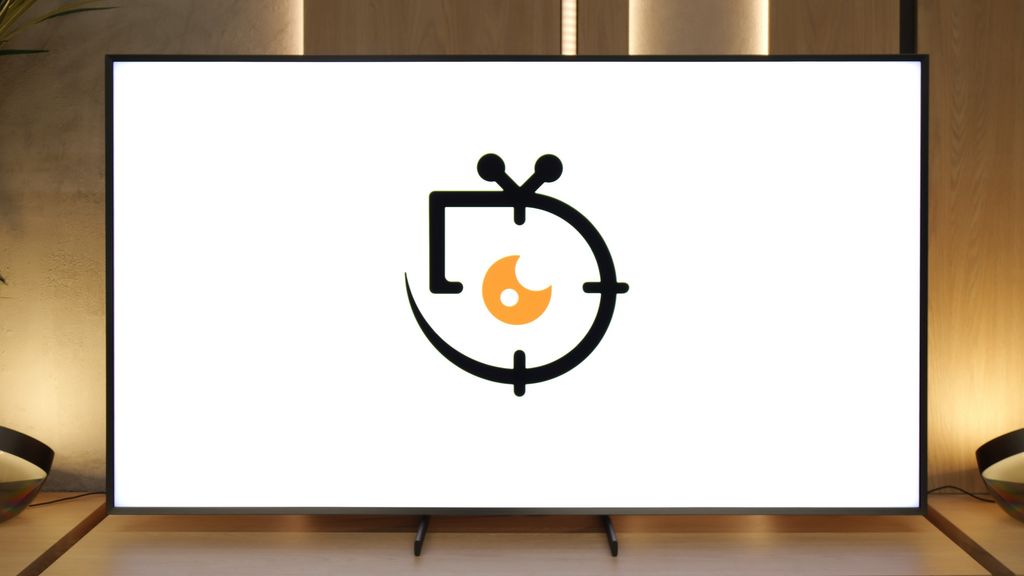
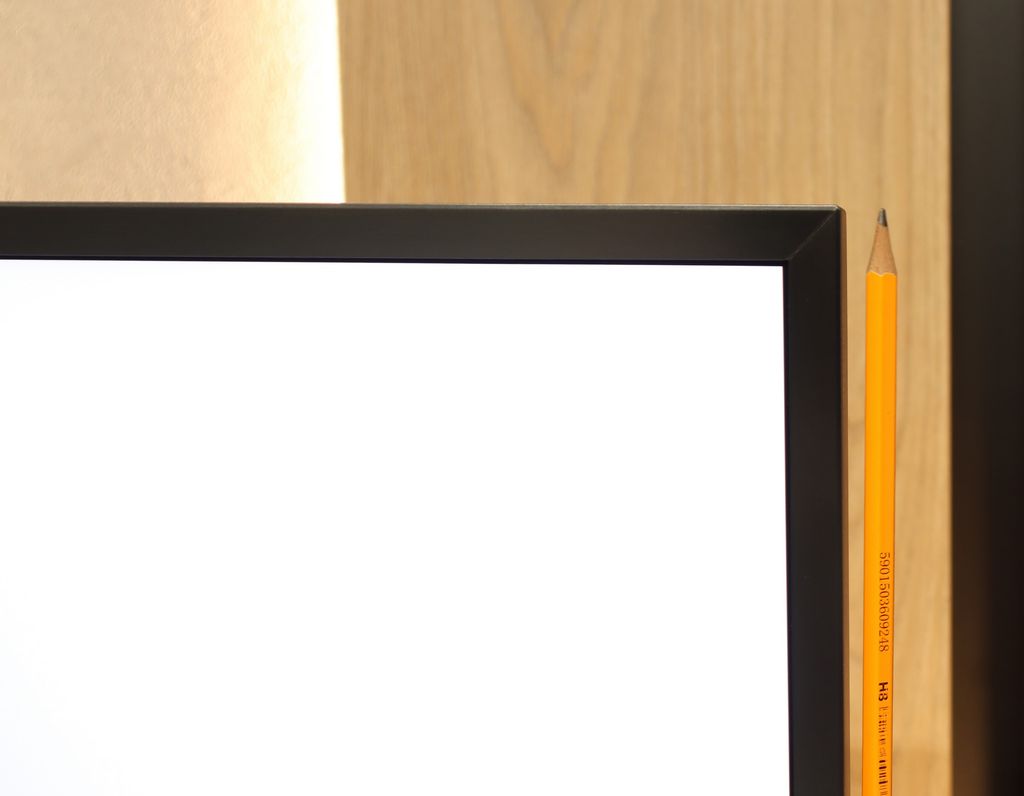
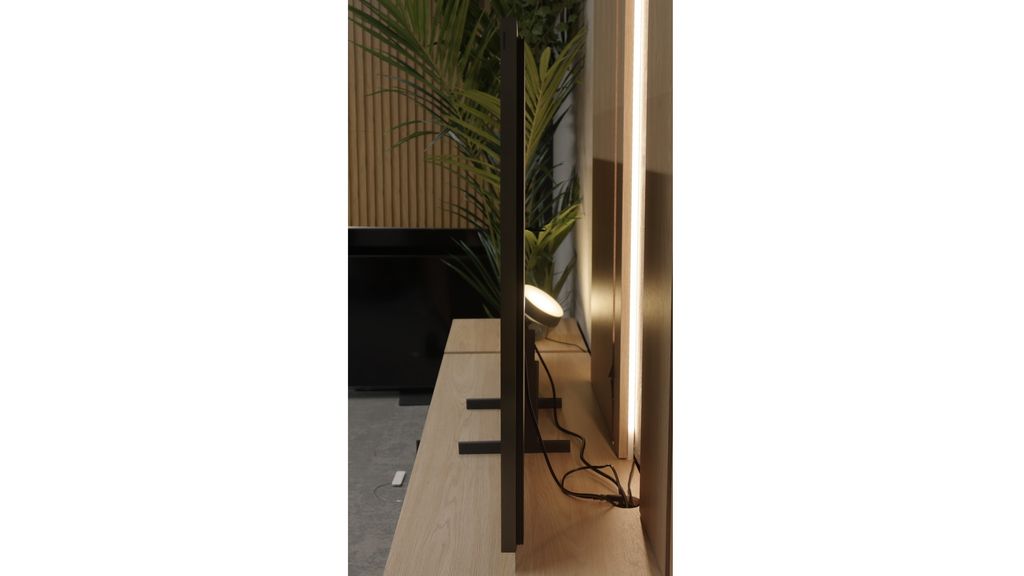
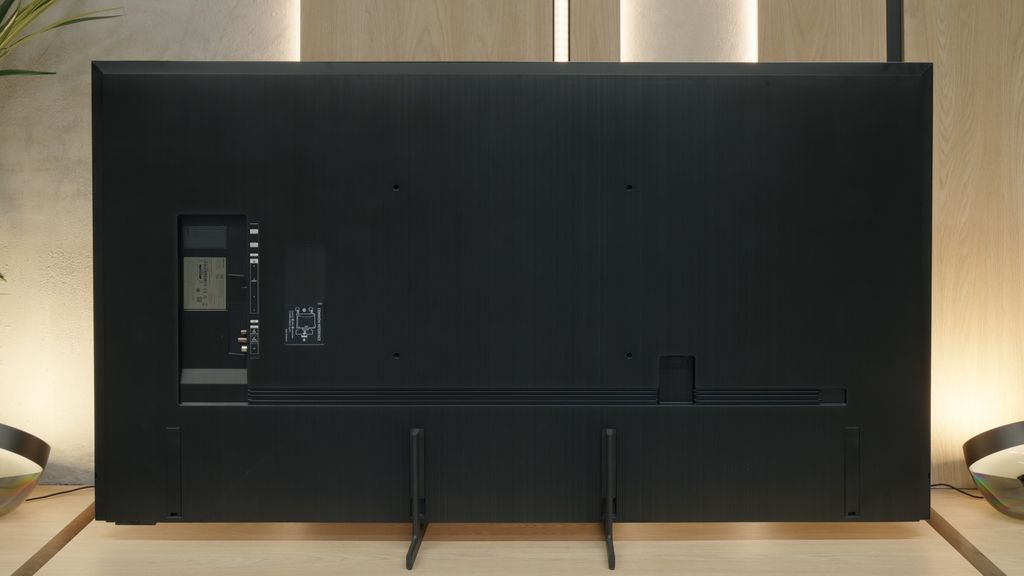
Contrast and black detail
8.3/10
7.2/10
Local dimming function: Yes, number of zones: 1344 (24 x 56)
Local dimming function: Yes, number of zones: 1056 (24 x 44)
Contrast:

Result
∞:1

Result
218,000:1

Result
61,000:1

Result
10,500:1

Result
4,900:1

Result
126,000:1

Result
41,650:1

Result
49,800:1

Result
5,350:1

Result
2,250:1
Halo effect and black detail visibility:

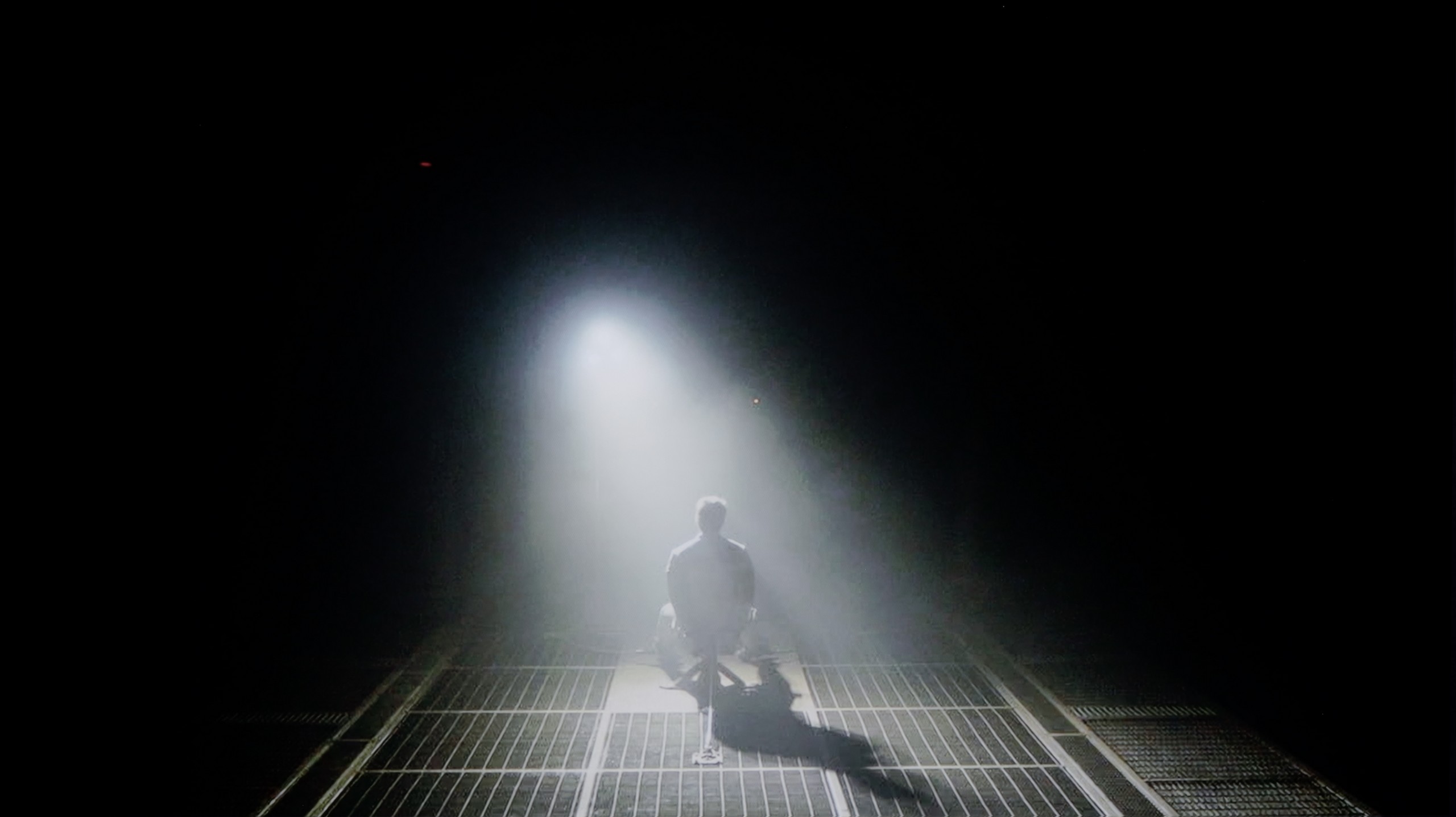
Samsung QN95D is a television that certainly attracts attention thanks to the use of a VA panel and innovative Mini LED backlighting. This model stands out with an impressive number of 1344 local dimming zones, achieving an exceptional level of contrast and black depth. It is worth noting that the number of backlighting zones may vary depending on the screen size – in larger models, these zones naturally increase, allowing for even better performance in terms of contrast and black levels. Mini LED, with smaller diodes, enables more precise control of backlighting, significantly enhancing the quality of the displayed image. The tested 55-inch model handles detail reproduction excellently, and its ability to adjust brightness in different parts of the screen results in a phenomenal visual effect. During our tests, Samsung QN95D on the test pattern from the film "Oblivion" surprised us with results that could compete with OLED televisions, offering nearly reference-level contrast. However, how does the television perform in more challenging conditions? In more demanding scenes, the local dimming algorithm may show some flaws. In some cases, on dark backgrounds, smaller bright elements may lose a lot of brightness, which we noticed during tests with the Pioneer Kuro test disc. Additionally, when we take a closer look (e.g. a scene from the film Sicario 2), some imperfections can be observed. The television sometimes struggles with brightness optimisation – in some scenes, it dims elements too much, while in others, it brightens the screen too intensely. These phenomena can be noticeable enough to capture the viewer's attention, especially in demanding night scenes. However, if we do not pay much attention to the mentioned imperfections, Samsung QN95D proves to be one of the best choices in terms of black depth among displays with MiniLED technology.
The QN900F is equipped with a VA panel, which in itself provides decent contrast, but that is not where its greatest strength lies. This is a mini-LED television, so we are dealing with local dimming technology, allowing specific zones of the image to be darkened. In the 65-inch variant, we counted as many as 1056 zones, which translated into really solid results. In the best possible scenario, the QN900F achieved a contrast ratio exceeding 100,000:1, which is absolutely impressive – at that moment, the black level was truly reminiscent of OLED. However, it must be remembered that it is not an OLED and has its classic mini-LED quirks. Since the television must decide which zone to brighten and which to darken, there are moments when the algorithm is not entirely sure what to do. This was the case, for example, in one of our test scenes, where the QN900F chose brightness over black depth, resulting in a significant drop in contrast to a level of 2300:1. Yes, the elements on screen were brighter, but around them, a characteristic glow (halo effect) was visible – the black then resembled a navy blue more. Generally, the black level on the QN900F is really very good – but not so good as to compare it with televisions featuring an organic panel.
HDR effect quality
6.7/10
6.4/10
Luminance measurements in HDR:

Result
1798 nit

Result
542 nit

Result
805 nit

Result
269 nit

Result
1528 nit

Result
1200 nit

Result
609 nit

Result
850 nit

Result
214 nit

Result
1415 nit
Scene from the movie “Pan” (about 2800 nits)


Scene from the movie “Billy Lynn” (about 1100 nits)


Static HDR10


Dynamic: HDR10+
Dynamic: HDR10+


HDR luminance chart:
Samsung QN900F
HDR luminance
Samsung Neo QLED QN95D
HDR luminance
Samsung QN95D handles HDR exceptionally well, achieving a peak brightness of around 2000 nits. In the tested movie scenes, where the screen is fully lit, the television provides intense and realistic representation of HDR content, significantly enhancing the visual experience. Nevertheless, similar to contrast, the dimming algorithm may sometimes show limitations. Despite the considerable number of Mini LED zones, the television does not surprise the user with incredible brightness. For instance, in scenes from the film "Life of Pi," where a bright moon appears against a dark background, and in excerpts from "Sicario 2," where a strong light effect occurs on a dark background, the television displays very poor results. At such moments, the television attempts to reduce the halo effect by darkening the image to a level reminiscent of SDR quality. As a result, blacks appear deep and uniform, but this comes at the cost of losing some detail in bright areas. It is a compromise aimed at maintaining the best possible quality of black, although it simultaneously causes the image to lose a bit of its dynamism. Despite certain flaws in the operation of the local dimming algorithm, this television deserves praise for its wide coverage of the DCI-P3 colour gamut. This is made possible by the use of a quantum dot coating, also known as QLED technology, which allows for vibrant and rich colours.
QN900F is truly a bright television – it can generate nearly 2000 nits, a figure that remains unattainable for most models available on the market. But the mere ability to achieve such brightness is not everything – it also matters whether the television can make good use of it. And here, it is not always perfect. Our tests on cinematic test patterns showed that in scenes such as those from Life of Pi or The Meg, the QN900F can truly shine – literally and metaphorically. In such moments, its greatest advantage, which is brightness, makes a huge impression. However, in more demanding scenes, challenges arise – similar to when assessing contrast. When smaller, bright elements appear on screen, the television often struggles with the decision: should it highlight them at the expense of black levels, or perhaps maintain deep blacks while toning down brightness. The result is situations where, for example, in the film Sicario 2, brightness dropped to just 200 nits, making details barely visible. Dimming algorithms could definitely be better for a television of this class.
Factory color reproduction
5.9/10
5/10


Factory Mode
After calibration


Factory Mode
After calibration
In the category of factory colour reproduction, the television Samsung QN95D was tested in Filmmaker mode, which offers the best settings from the manufacturer. Nevertheless, it is not entirely free from flaws. In the case of HD content, there is a noticeable colour deviation, particularly in white balance, where the red colour clearly dominates the graph. The situation improves with 4K HDR content; however, there are still significant drops in blue colour reproduction. These effects can be observed in a scene from the film "Star Wars," where the protagonist is depicted in overly warm tones.
As for contrast, we can observe an initial large jump on the gamma graph, indicating that the television effectively highlights the brighter parts of the image. However, at the end of the graph, we notice a distinct drop, which may mean that in darker tones, details can be lost. Such a shape of the gamma curve can affect the way users perceive dark scenes, where some details may become too blurred or too dark, causing the image to lose clarity. It is also worth noting the curve responsible for brightness (EOTF), which is quite correct, except for the initial drop.
Although Samsung QN95D boasts impressive parameters and advanced technologies to deserve the title of one of the best televisions on the market, it requires certain adjustments in colour reproduction and contrast to fully utilise its potential.
Testing the QN900F in Filmmaker mode, the characteristic features of the image were quickly noticeable, even though this mode is designed to reflect the director’s vision. The white balance was not perfect – the television displayed distinct deficiencies in the blue colour. This made the entire scene take on a warmer tone, as if someone had applied a subtle filter in shades of yellow and orange. In films where bright shots dominate – for example, scenes in the snow or in strong daylight – this gave the impression of slight warmth that did not always convey the director's intent. The second noticeable element was the management of brightness. The QN900F could sometimes brighten the image more than necessary. It looked as though the exposure had been slightly 'pulled up', causing the scene to lose its naturalness. Shadows were sometimes too shallow, and the contrast slightly weakened. These are not disqualifying errors, but for a television in this price range, it is evident that Filmmaker mode has not been perfected one hundred percent. This is particularly noticeable when we compare its image with what was seen after the screen calibration.
Color reproduction after calibration
8.9/10
8.7/10




After calibration, the picture on the Samsung QN95D television achieves truly impressive results. The white balance is perfectly aligned, and error readings rarely exceed 2, which means that colours are displayed very accurately. Most samples from the Color Checker test fall within an acceptable error range, confirming that the television reproduces hues excellently. The contrast has also improved significantly, and the gamma curve is more stable, resulting in better visibility of details in both dark and bright scenes. However, it is worth noting the EOTF (Electro-Optical Transfer Function) curve, which shows some discrepancies in film tests. Although the television performs well in most scenes, details in the blacks can still be lost in more extreme cases – this is due to an aggressive dimming algorithm.
Nevertheless, these minor imperfections do not detract from the overall picture quality. After calibration, the Samsung QN95D impresses with its visual quality, offering an exceptional experience that will certainly satisfy anyone looking for a top-tier television.
After calibration, we managed to eliminate errors in white balance and adjust them to a level that can be considered acceptable. It is not perfect, but it is definitely better than the factory settings. Most colour errors now lie within the deltaE 2–3 range, so in practice, they should not be noticeable during everyday viewing. However, the most significant improvement is evident in how the television manages brightness in SDR content. Shadows and details are no longer flattened, which gives the image depth and naturalness. As for 4K HDR material – colours themselves are no longer an issue, but some imperfections of Mini-LED technology can still be observed. The QN900F tends to dim the smallest bright elements too much, causing them to sometimes disappear from view. However, it should be noted that this is a much better solution than boosting the entire screen, which would spoil the contrast. This is more of a characteristic of this technology than a typical flaw, but it is worth keeping in mind. The effects of calibration are truly very good.
Smoothness of tonal transitions
9.1/10
8.3/10





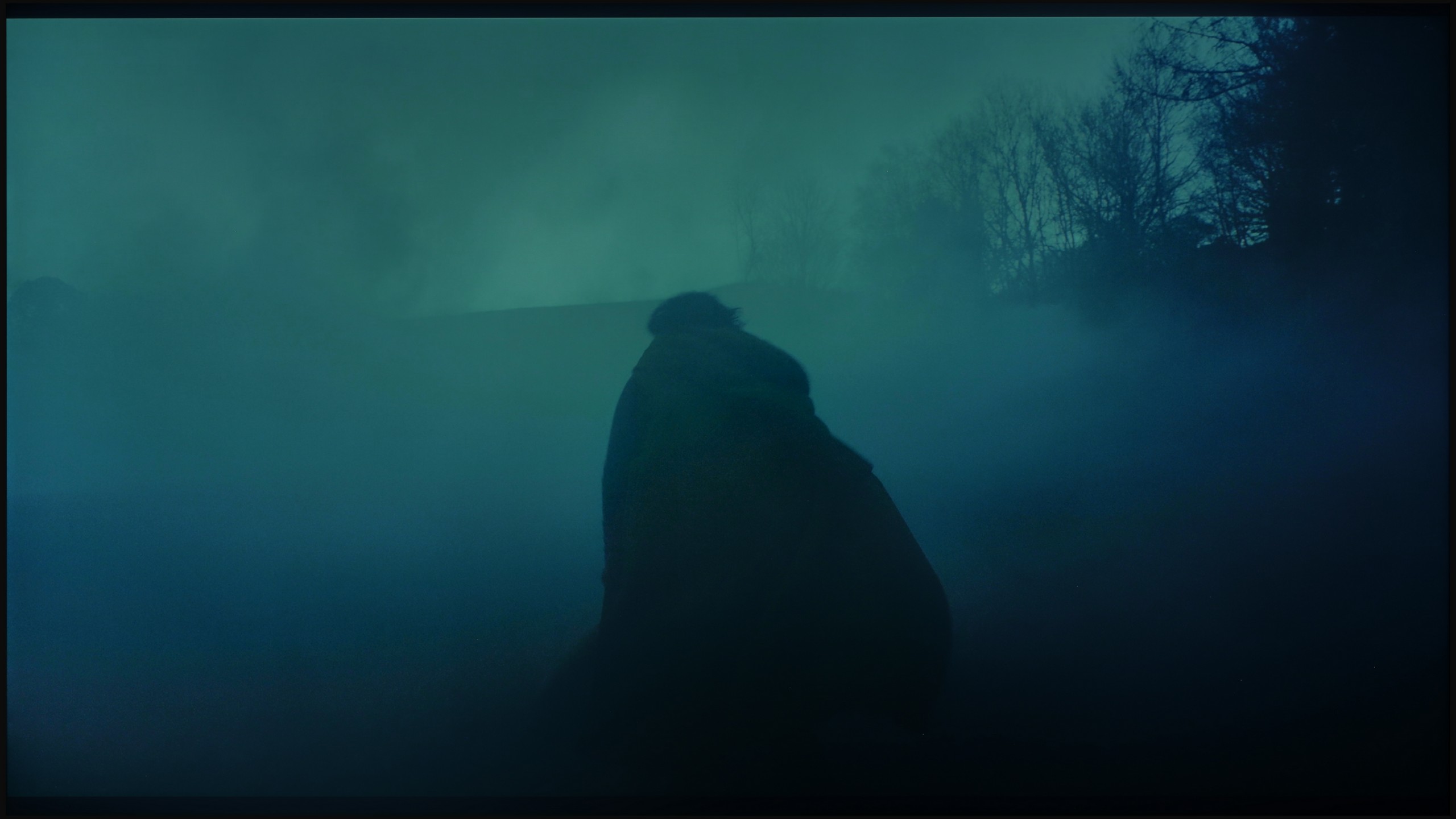






The fluidity of tonal transitions is one of the strongest points of the Samsung QN95D television, which received a very high rating in this category. Such results are rarely seen in televisions that offer such high brightness. Thanks to the precise operation of the panel, tonal transitions are exceptionally smooth and natural. The only noticeable shortcomings might be slight errors around the blacks, but they are subtle enough that most users are unlikely to notice them. This makes the Samsung QN95D an excellent choice for those who value image quality and detail, especially in scenes with complex lighting.
QN900F performs really very well in terms of gradation. The tonal transitions are smooth and natural, without clear contours or banding. Interestingly, it is one of the few televisions that handles dark transitions better than light ones – we only noticed slight imperfections in heavily brightened scenes like that from the film Kingsman. In most cases, the picture simply looks very good and we have nothing to complain about.
Image scaling and smoothness of tonal transitions
7.2/10
7.5/10
Smooth transition function

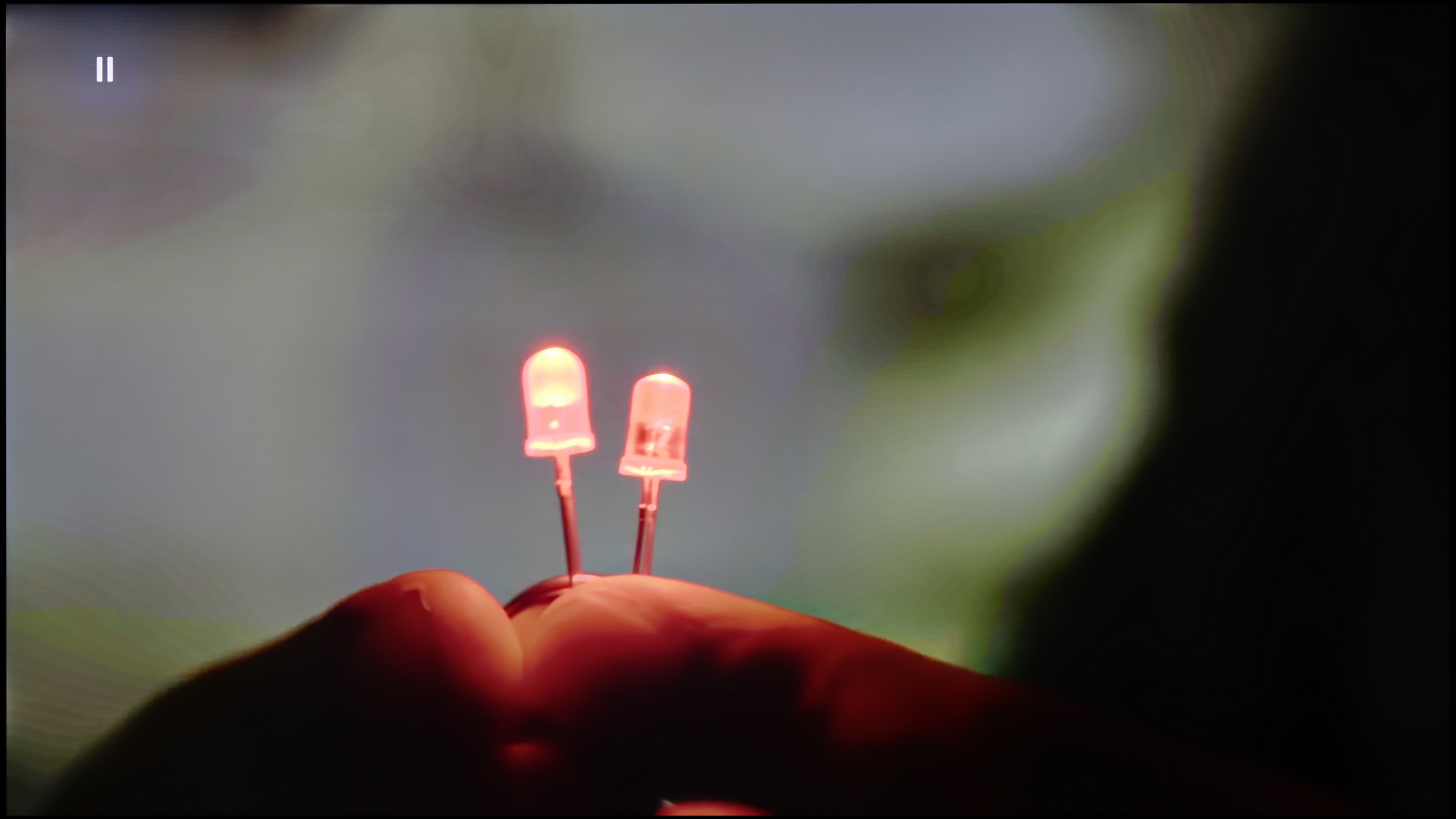
Image without overscan on the SD signal


The Samsung QN95D television handles tonal transitions even in lower quality materials, thanks to the noise reduction feature employed, which functions like a gentle gradation. This feature is extremely effective, smoothing out the image and eliminating unwanted noise while significantly improving the quality of the displayed material. However, as is often the case, too much effectiveness can lead to unintended side effects. In some materials, this feature may also blur elements that should remain sharp, such as film grain.
Despite this, the television performs well in the context of image scaling, eliminating larger jagged edges. In a scene where branches are visible, they are not excessively artificially sharpened, allowing for a natural appearance, and the model does not have an artificial outline. Overall, this means that even in more challenging conditions, the film material presents itself satisfactorily on the Samsung QN95D. The only downside when watching HD/SD content (such as regular terrestrial television) is the fact that we have a slightly cropped image – this is caused by the so-called overscan, which cannot be turned off.
If we want to eliminate jarring tonal transitions that can be irritating, for example, while watching YouTube, we can use a feature called noise reduction. It works really effectively – it removes issues with colour blending when we set it to Standard level. However, as with most Samsung televisions, this does involve some compromises. Although we did not notice this feature significantly affecting the structure of objects in the image, it unfortunately reacts quite aggressively to film grain. Most people will likely appreciate this effect – the noise is simply removed – but if someone is looking for an image as close as possible to reference settings, we definitely recommend turning this option off.
When it comes to scaling, or dealing with very low-quality content, the QN900F performs really well. On the test card with the model, the image appeared clear, with only slight aliasing that shouldn't bother most viewers. However, it is worth mentioning one issue – the television sometimes has problems with so-called overscan, which can cause older content to be slightly cropped. This might manifest, for example, in subtitles disappearing from the bottom of the screen.
Blur and motion smoothness
7.5/10
7.8/10

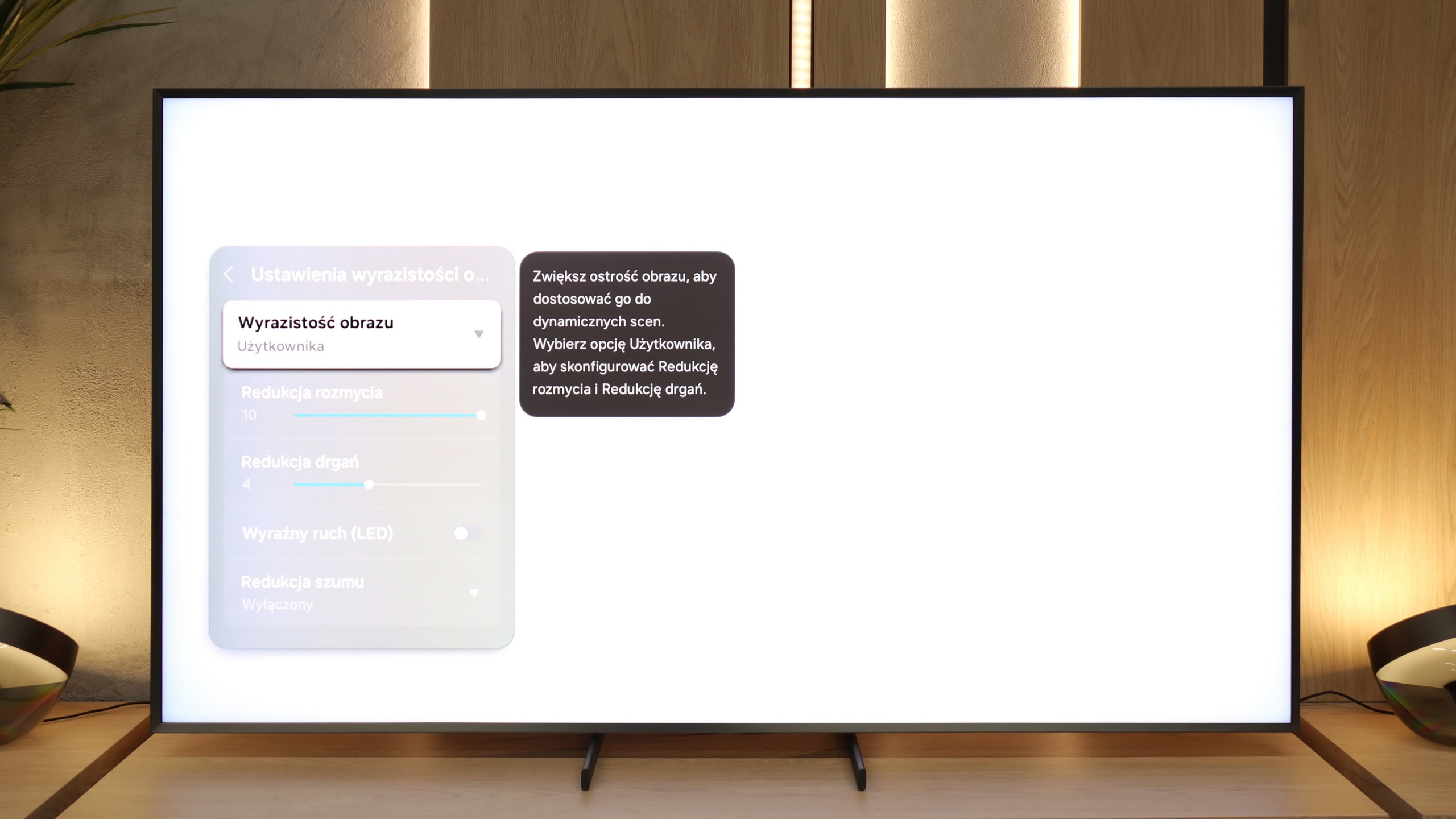
Blur (native resolution, maximum refresh rate):




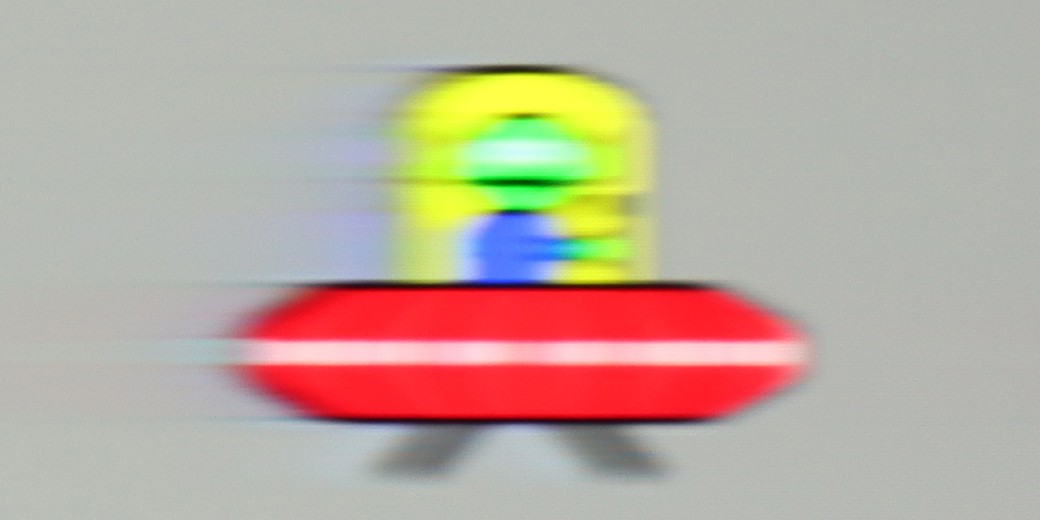
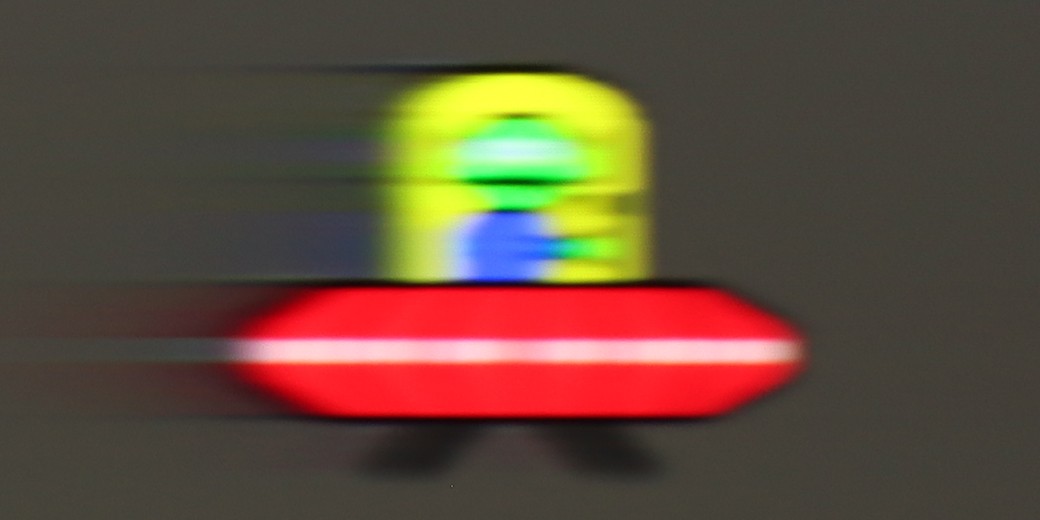
Blur (BFI function enabled):
Image flickers in this mode



Image flickers in this mode
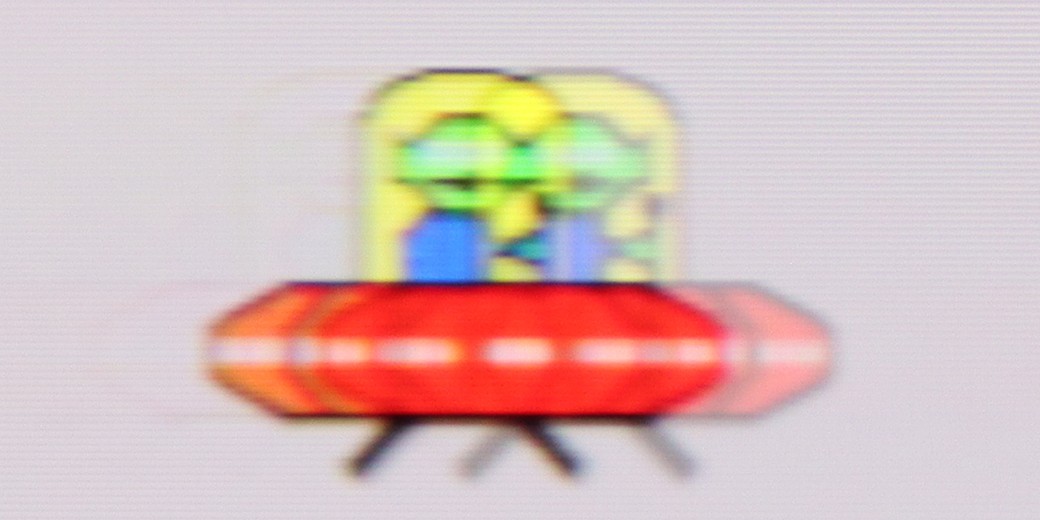


Smużenie ():
Smużenie (4K@165Hz):
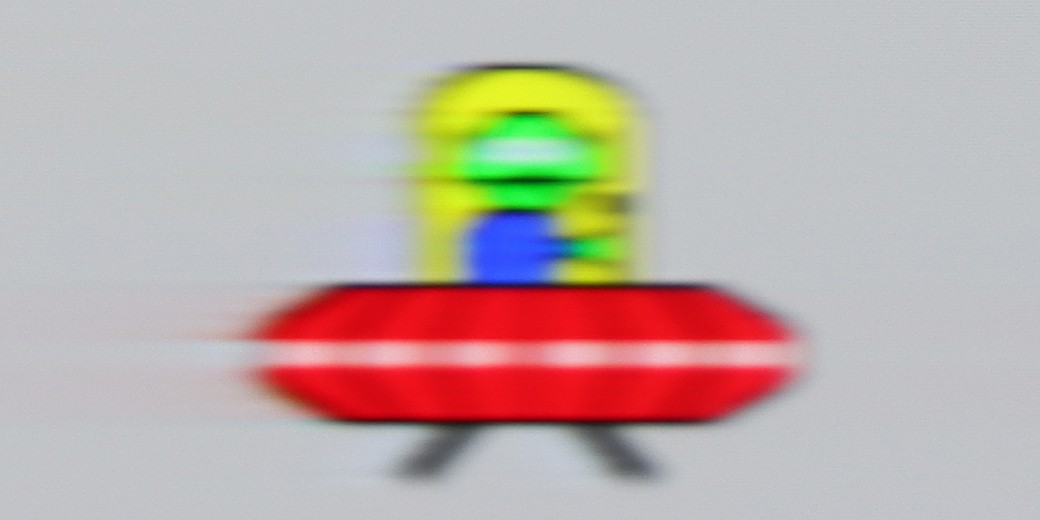
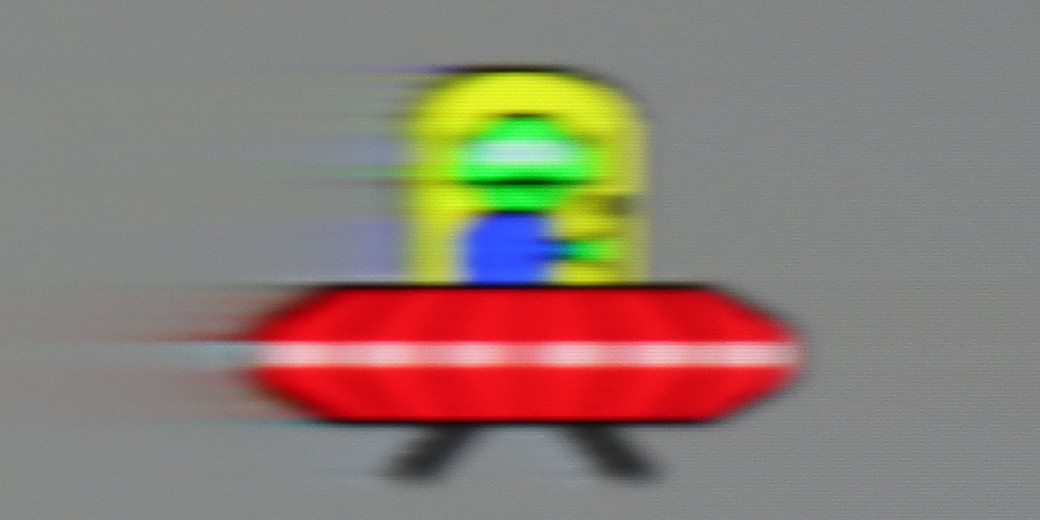
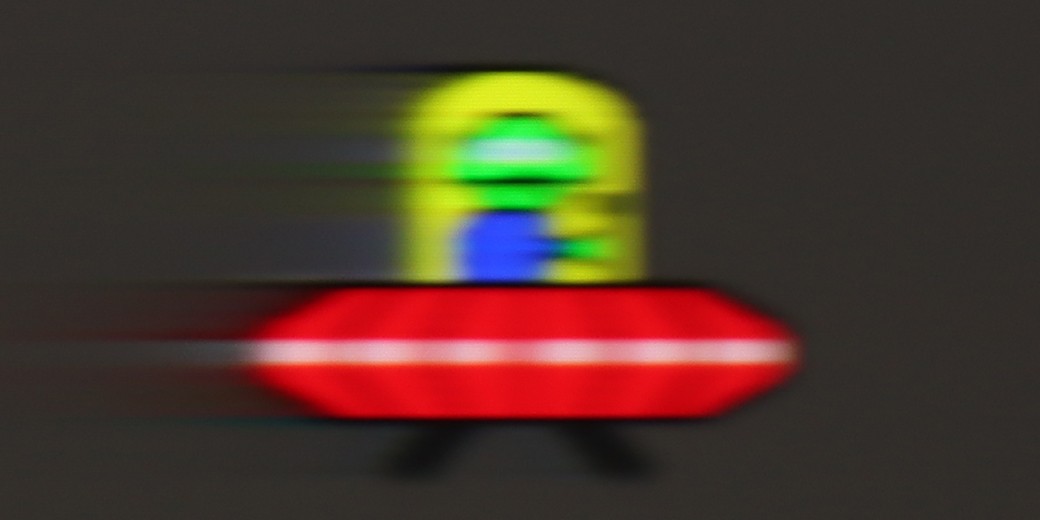
The panel in Samsung QN95 performs very well in terms of motion blur and smoothness of movement. With a refresh rate of 120 Hz and features for reducing blur and judder, the picture settings can be customised to personal preferences, whether for watching films or for dynamic sports broadcasts. The user has the option to adjust the smoothness of the image on a 10-point scale – from a more frame-like appearance reminiscent of traditional film to a smooth, almost theatrical effect, which works particularly well for sports transmissions.
There really is nothing to complain about here – the QN900F looks very good in terms of motion. With a 165 Hz panel in 4K, it can confidently be said that this television is suitable for both watching sports and gaming. The motion enhancer plays a key role here. It works brilliantly – not only during sports broadcasts, where it can eliminate blurring and image shaking, but also in games, where the animation becomes clearer and smoother. And of course, if someone likes to experiment with films – they also have that option. At lower settings, a slight graininess and cinematic character can be seen, while at higher settings, it takes on a soap opera effect. In other words, everyone can adjust the picture to their preferences, and the television has the power to handle it.
Console compatibility and gaming features
9.5/10
8.2/10
- ALLM
- VRR
- VRR range48 - 144Hz48 - 165Hz
- Dolby Vision Game Mode
- Correct implementation of HGIG
- 1080p@120Hz
- 1440p@120Hz
- 4K@120Hz
- Game bar

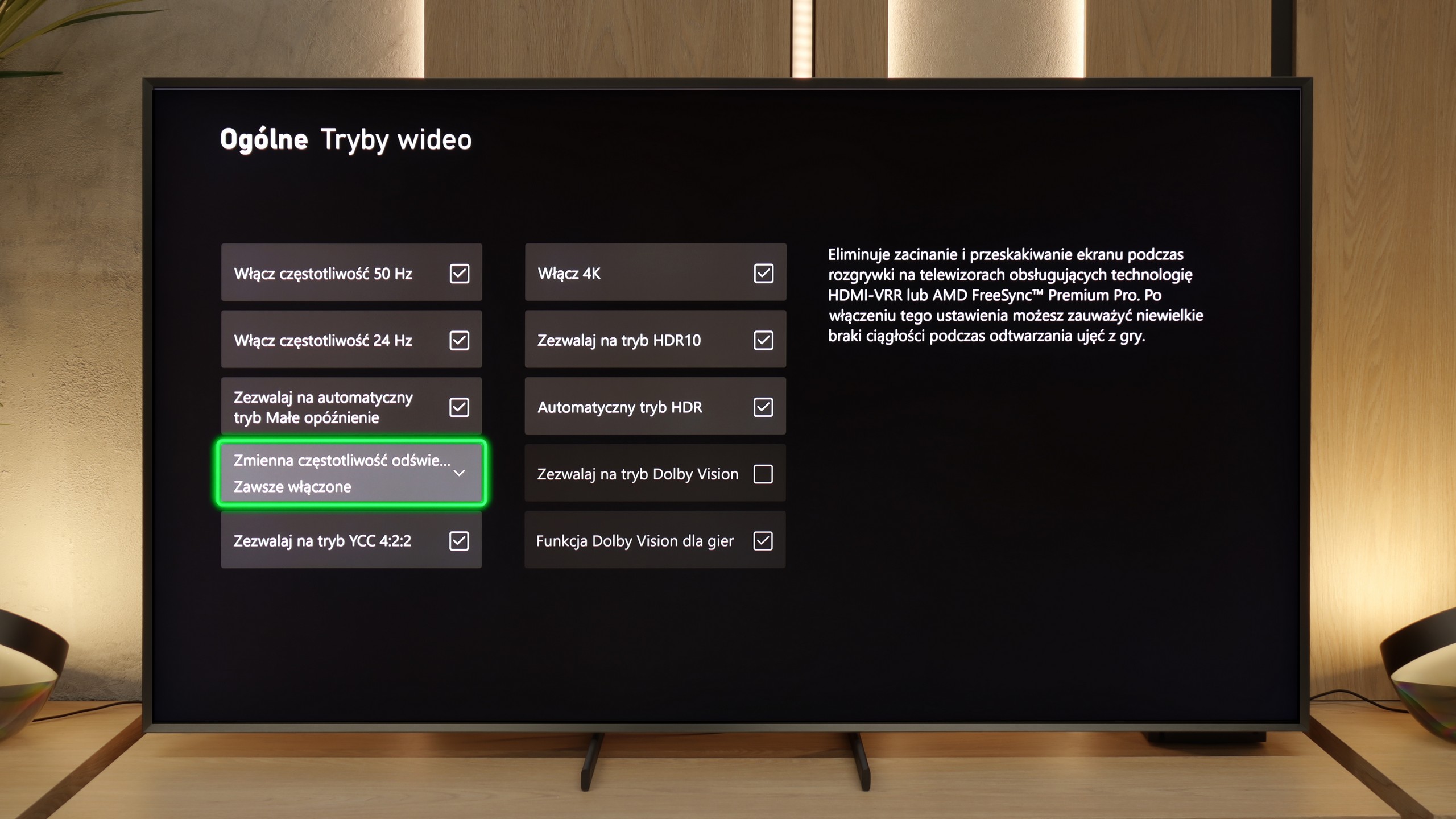

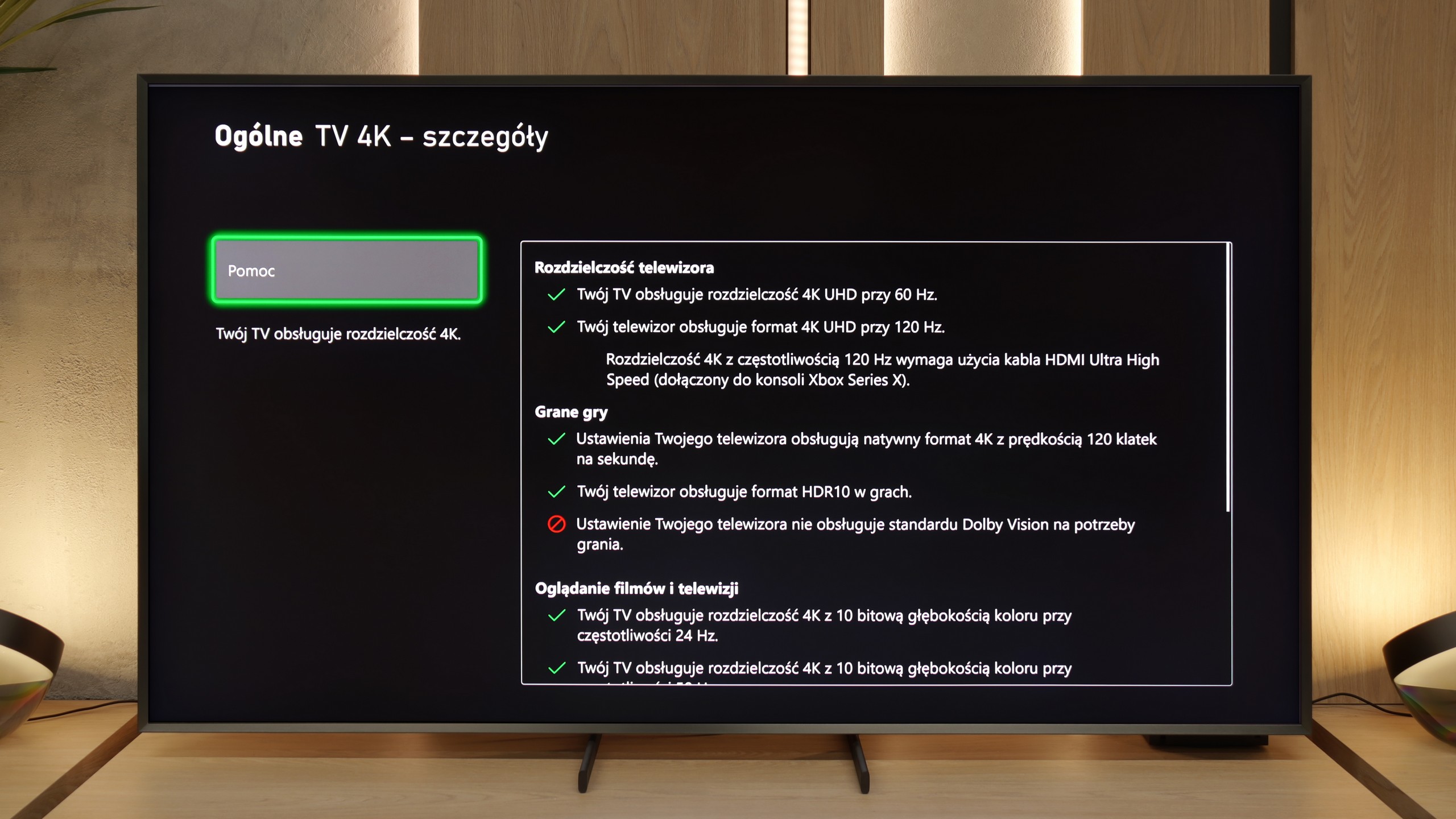

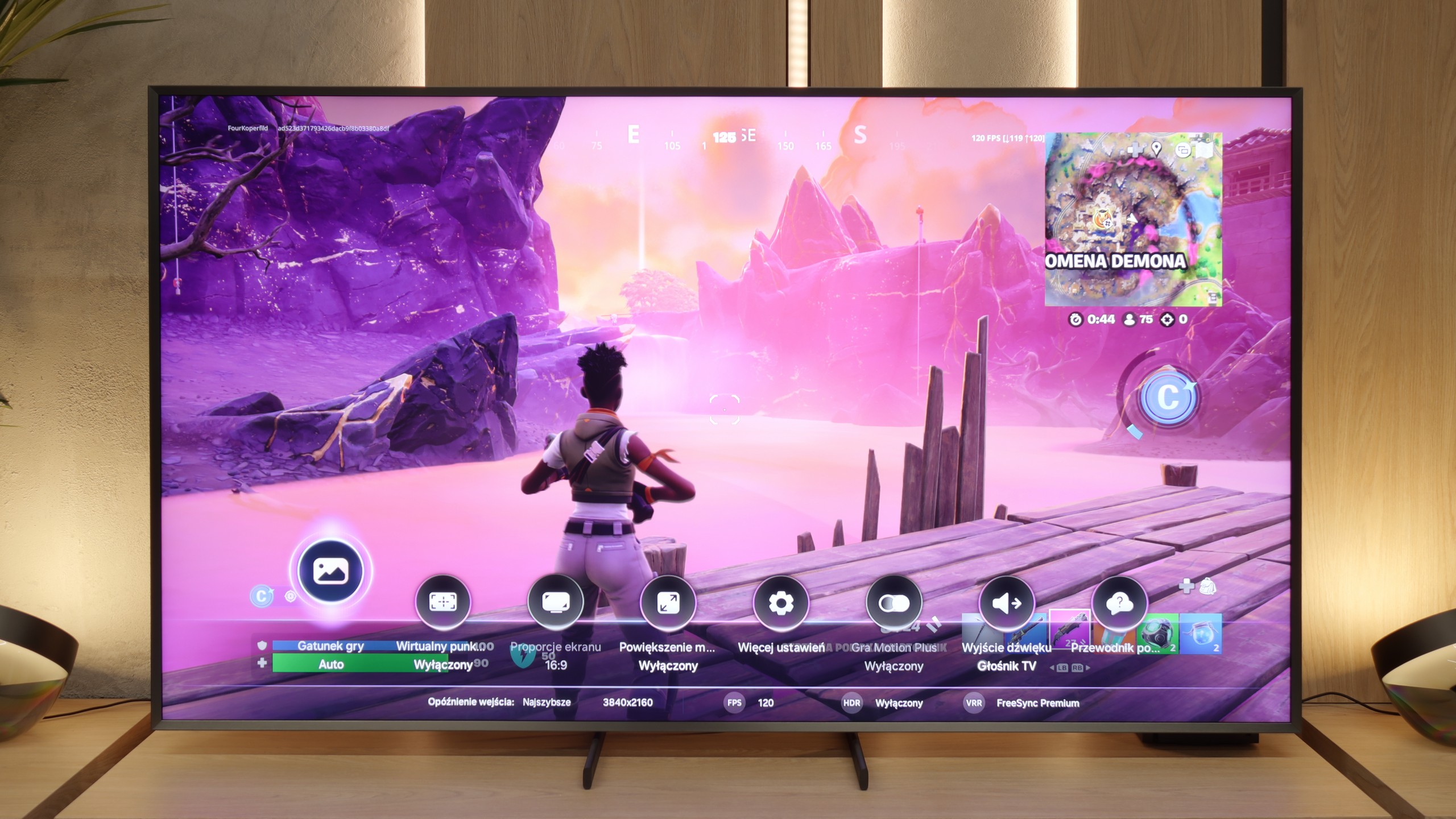

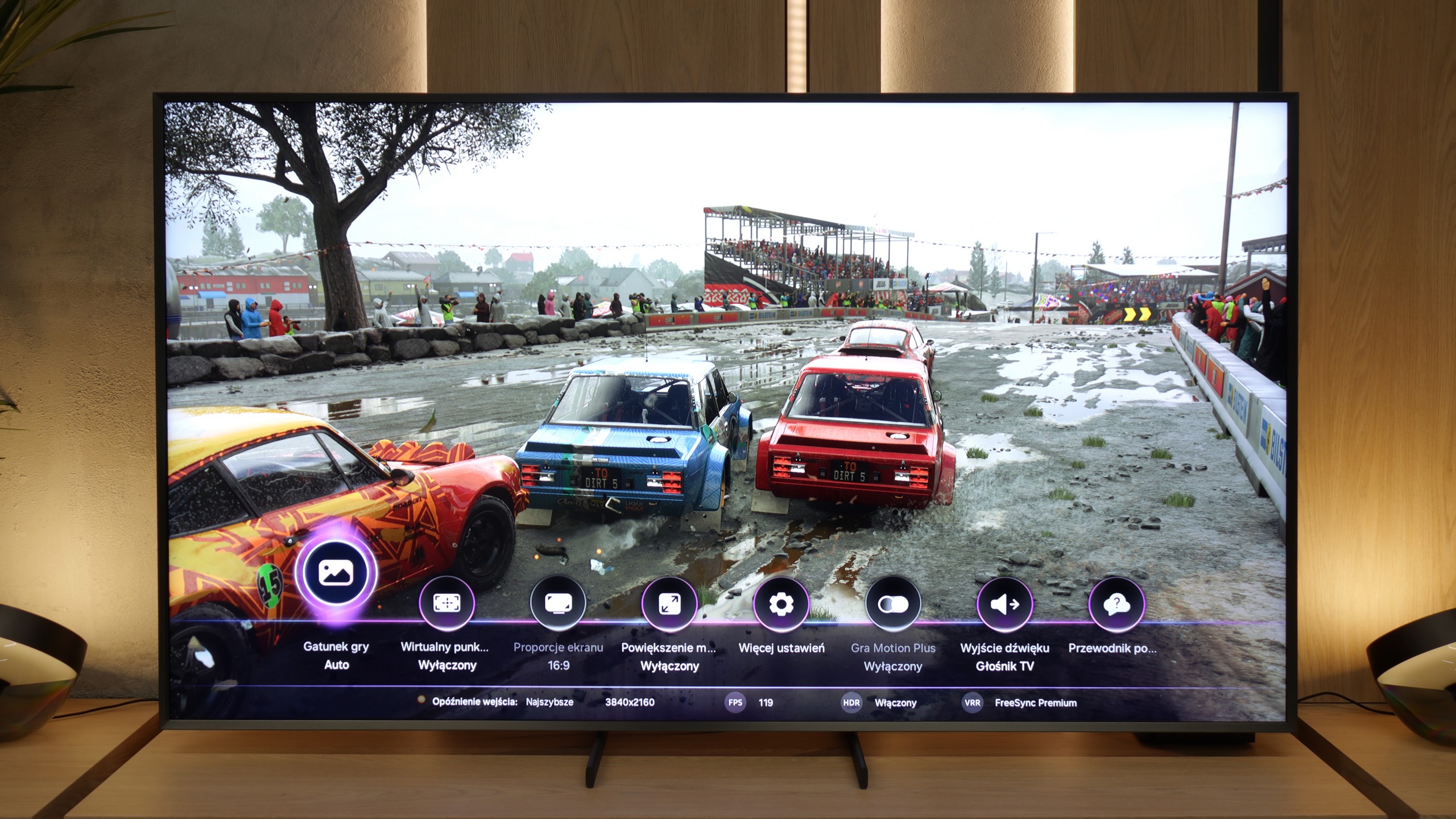
Samsung QN95D offers quite a few features that gamers will appreciate. First and foremost, the television supports variable refresh rate (VRR), which allows for smoother gameplay, eliminating issues with tearing, especially during dynamic scenes. We also find the auto low latency mode (ALLM) feature, which automatically switches the television to low latency mode when it detects a connected console or computer, ensuring more responsive controls.
Furthermore, the QN95D Samsung has a game mode that reduces input lag to a very low level, which is crucial in games where reflexes play an important role. With a high refresh rate of 120 Hz, the picture is exceptionally smooth, significantly enhancing the experience of fast-paced action games and sports productions. The television also supports G-Sync and FreeSync technologies, which further enhance gameplay smoothness and improve user comfort. An interesting addition is the 'Game Bar' – a special menu that provides quick access to all game-related settings, allowing easy adjustments of picture and parameters to suit user preferences without the need to interrupt gameplay.
Although the Samsung QN95D does not support Dolby Vision – which is quite obvious for Samsung televisions – it does offer the HGiG feature, which ensures appropriate picture quality in HDR games, in line with the creators' vision.
It really is nice here. The QN900F offers a full set of features that we would expect from a top-end gaming television – we have VRR, ALLM, Game Bar, and also cloud gaming applications. However, the biggest standout is the proprietary motion smoother, which also works in games and – importantly – does not introduce noticeable lag. This is something we won't find with its other competitors.
Unfortunately, there is also something concerning. This year, Samsung has evidently messed something up with its televisions. During the testing of the QN900F before its update, it had the HGIG feature, which allowed for perfect adjustment of HDR settings for the console. However, according to our procedures, we always update the equipment to the latest version – in order to give the manufacturer a chance to fix any shortcomings. And here… it turned out the opposite.
After the update, the HGIG feature disappeared from the menu, making the correct configuration of the console for HDR practically impossible. It was supposed to be complete – 165Hz, four HDMI 2.1 ports, a full gaming package… but unfortunately, it turned out to be a small blunder. What a shame.
Input lag
9.8/10
9.8/10
SDR
HDR
Dolby Vision
QN95D Samsung stands out with excellent input lag performance, achieving values below 15 ms. This is an impressive result that is not dependent on resolution or refresh rate. With such low latency, gamers can enjoy the TV's instant response to their commands, which is crucial in dynamic games. Whether we are playing 4K titles at 120 Hz or lower resolution games, the QN95D ensures exceptional gameplay smoothness and precise motion rendering. Such a level of responsiveness makes the TV an ideal choice for any avid gamer.
In terms of input lag, the QN900F presents a class of its own. Regardless of the set resolution or refresh rate, the response time remains instantaneous. It's one of those televisions where it's genuinely difficult to perceive any delay. Gamers can rely on complete responsiveness and the assurance that every action from the controller will be immediately mirrored on the screen. In this category, it is simply the highest tier.
Compatibility with PC
8.6/10
8.4/10


In the category of collaboration with a PC, the Samsung QN95D television stands out with its high performance, offering support for 4:4:4 chroma and impressively low input lag. Thanks to these features, users can enjoy fluidity and responsiveness, making it an ideal choice for office work or everyday applications. However, one noticeable issue is the poor visibility of horizontal lines on a dark background. In the test image on the right, it is evident that the letters resemble vertical lines, which can be somewhat frustrating. Nonetheless, the television generally offers good compatibility with a computer, and users can expect comfortable operation in their daily tasks.
QN900F is an 8K television, so even in a larger size, it can be treated as a legitimate work monitor – of course, provided that someone can actually fit such a colossus on their desk. The device supports 4:4:4 chroma, so overall font readability is good, though we noticed some issues with the thinnest lines. This may stem from the fact that at a native 8K resolution, some texts are simply so microscopic that the television is not necessarily ideally suited for it. It sounds a bit absurd, but how else can we explain it? 😉
On the other hand, the QN900F can be a great choice for PC gamers. It supports G-Sync technology, and at a 4K resolution, it offers refresh rates of up to 165 Hz. So if you have a very powerful computer, the QN900F will allow it to spread its wings and showcase its gaming prowess in all its glory.
Viewing angles
7.1/10
5/10
In the case of TVs with VA panels, one can usually expect limited viewing angles; however, QN95D Samsung surprises in this category. Thanks to the applied coating that widens viewing angles, the TV offers really good performance, which is rarely seen in devices with this type of panel. Although VA panels are usually not the best in this regard, in this model, the picture remains clear and vivid even when viewed from the side, making it an excellent choice for larger rooms and group watching.
The viewing angles on the QN900F are really quite good, but we have the impression that the 'Ultra Viewing Angle' coating that Samsung heavily advertises performs worse than last year. Yes – the effect is still much better than in most LCD TVs with VA panels, but it still falls short of OLEDs or good IPS panels. The image holds up decently when viewed from the side, and the colours don't fade as quickly as in standard VAs, however, we expected something more, especially since previous generations from Samsung have performed better. Perhaps the additional matte coating that has appeared in this year's 8K series is having an effect on this.
TV efficiency during daytime
6.5/10
7.1/10

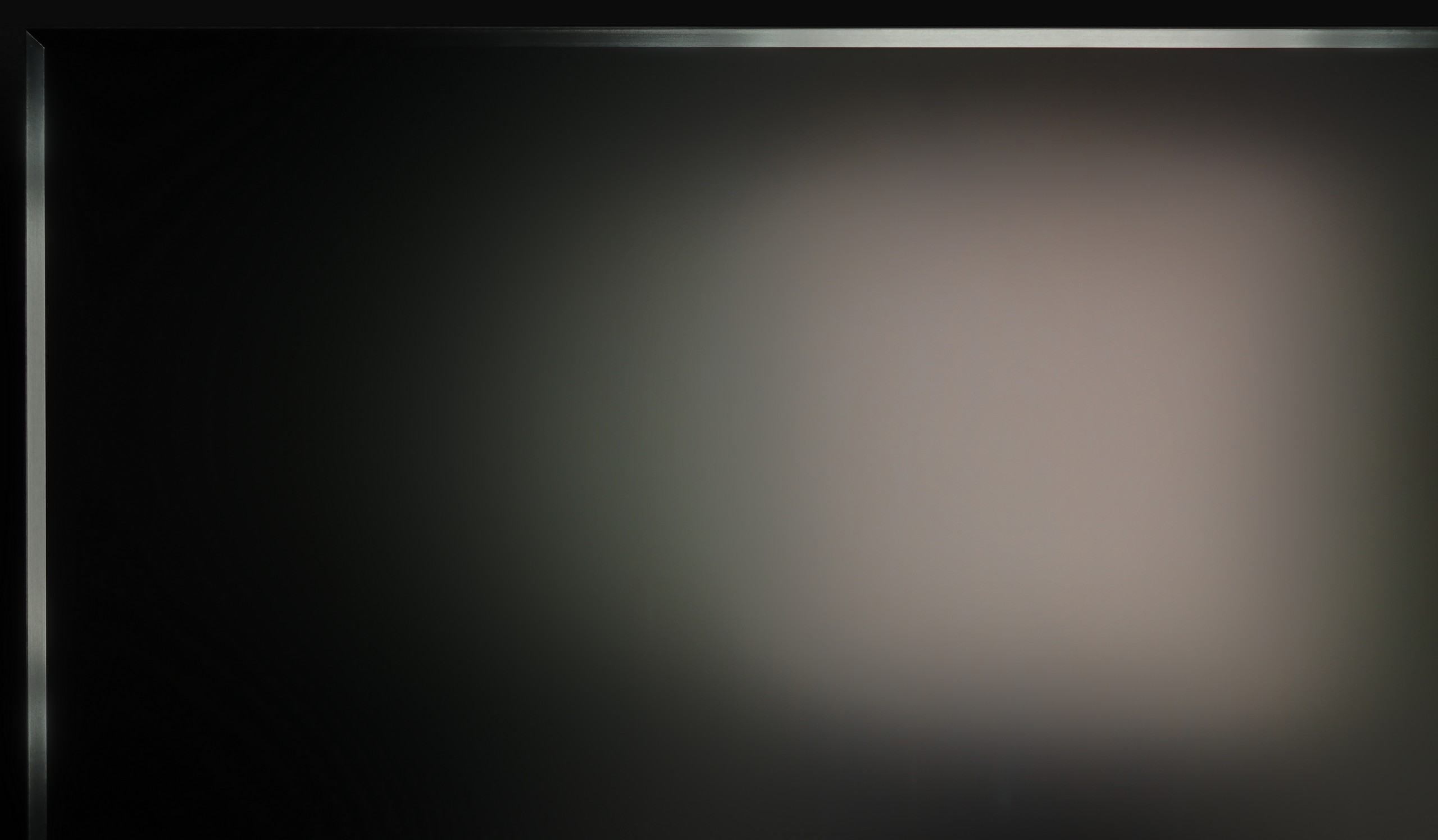

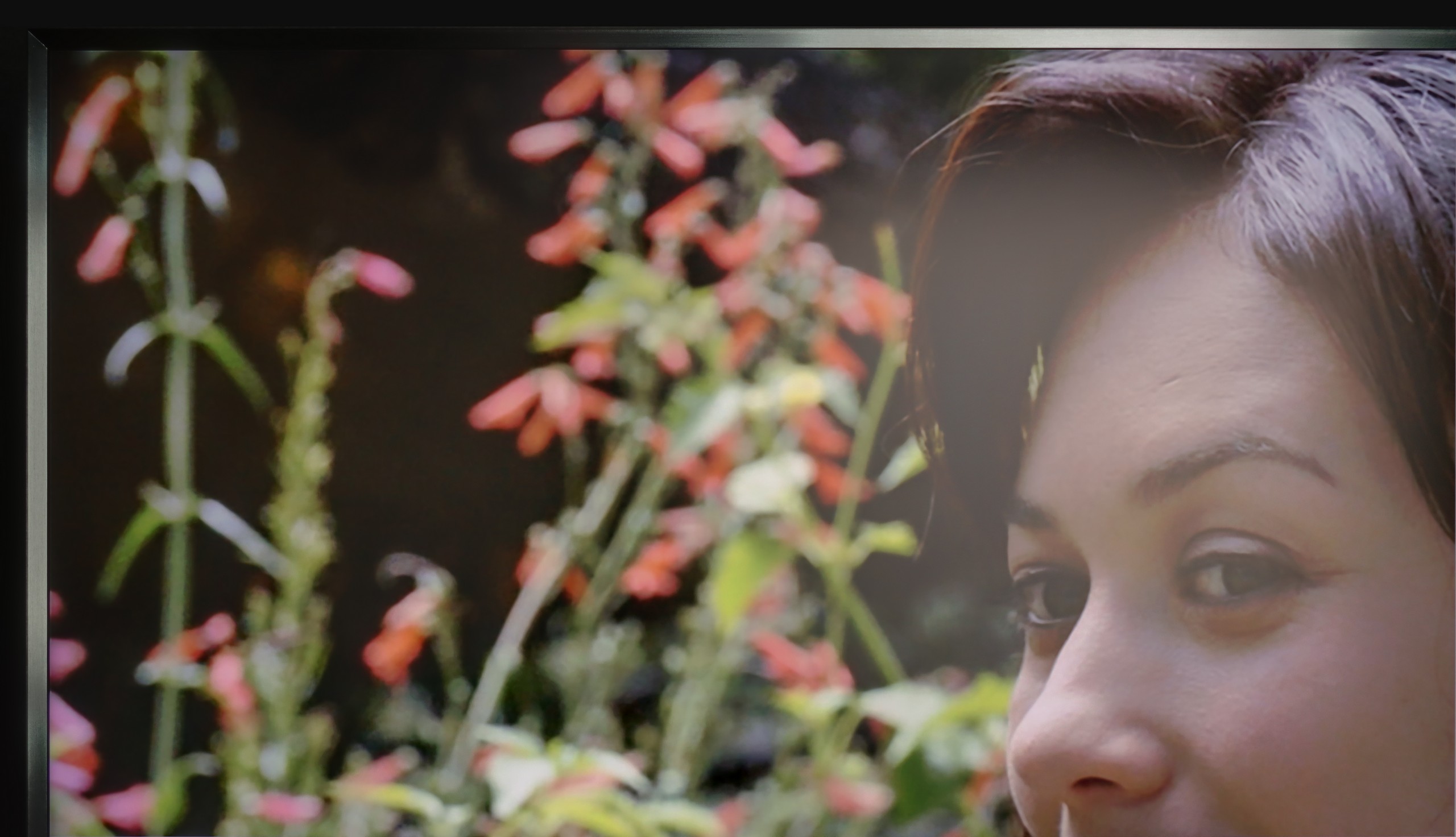
Matrix brightness
Average luminance SDR
Samsung QN900F: 723 cd/m2
Samsung Neo QLED QN95D: 655 cd/m2
In the daytime performance category, QN95D Samsung, despite using a glossy panel, may struggle with highly visible reflections on the screen. As seen in the photo on the right, the lamp disperses to the left and right, which is a result of the anti-reflective coating used. However, overall this coating performs very well when the television displays any colours other than black, where reflections become more noticeable. It is worth noting that the television achieves very high brightness for SDR content, exceeding 650 nits, which provides comfortable viewing even in bright rooms.
One of the innovations in 8K from Samsung is the matte display. This year, the Koreans have been gradually "mattifying" their televisions, and it must be said that the QN900F is at the very top of the game in this regard – reflections are suppressed better than in any other model on the market. In practice, this means that even in a brightly lit living room, the picture remains clear, and reflections nearly disappear from the screen. Of course, such a coating also comes at a cost. Colours lose some intensity, and black does not appear as deep under strong light as on shiny screens. But this is more of a detail than a real problem, as the richness of colours and depth of black are most important in the evening, with the lights turned off – and then this effect completely disappears.
Details about the matrix
Subpixel Structure:

Panel uniformity and thermal imaging:

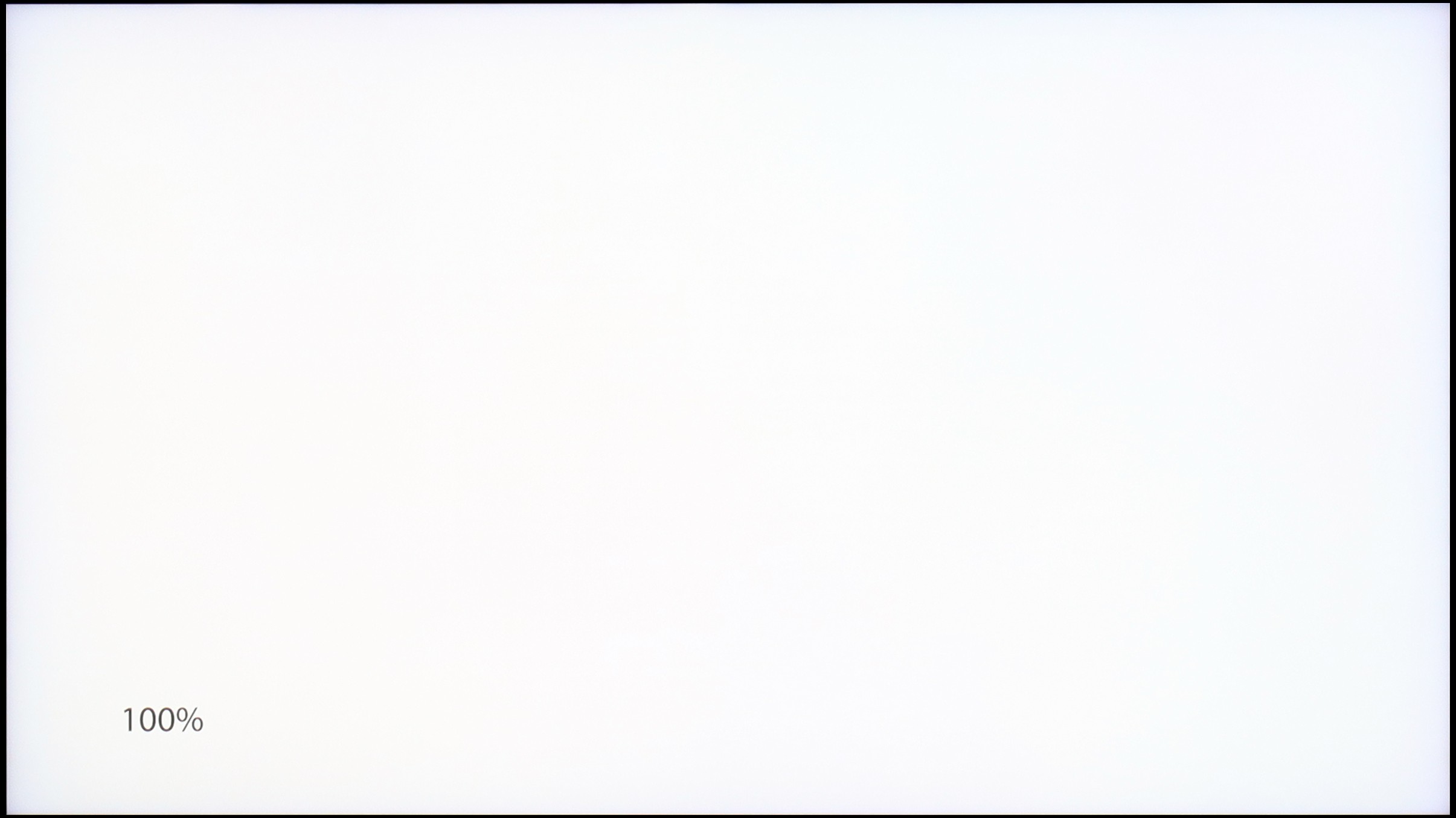
Samsung Neo QLED QN95D
Samsung QN900F
TV features
6.7/10
7.2/10
- HDMI inputs0 x HDMI 2.0, 4 x HDMI 2.1 48Gbps0 x HDMI 2.0, 4 x HDMI 2.1 40Gbps
- Other inputsToslink (Optical audio), IR (remote)
- OutputsToslink (Optical audio), eARC (HDMI), ARC (HDMI)Toslink (Optical audio), eARC (HDMI), ARC (HDMI)
- Network InterfacesWi-Fi 2.4GHz, Wi-Fi 5GHz, Ethernet (LAN) 100MbpsWi-Fi 2.4GHz, Wi-Fi 5GHz, Ethernet (LAN) 100Mbps
- TV receptionDVB-T, DVB-T2, DVB-S, DVB-S2, DVB-CDVB-T, DVB-T2, DVB-S, DVB-S2, DVB-C
Classic features:
- Recording to USB (terrestrial TV)
- Recording programming
- Picture in Picture (PiP)
- RF remote control (no need to aim at the screen)
- Backlit remote control
- Teletext
- Audio only mode
- Bluetooth headphones support
- Simultaneous Bluetooth headphones & TV audio
Smart features:
- AirPlay
- Screen mirroring (Windows Miracast)
- Voice search
- Voice search in native language
- Ability to connect a keyboard and mouse


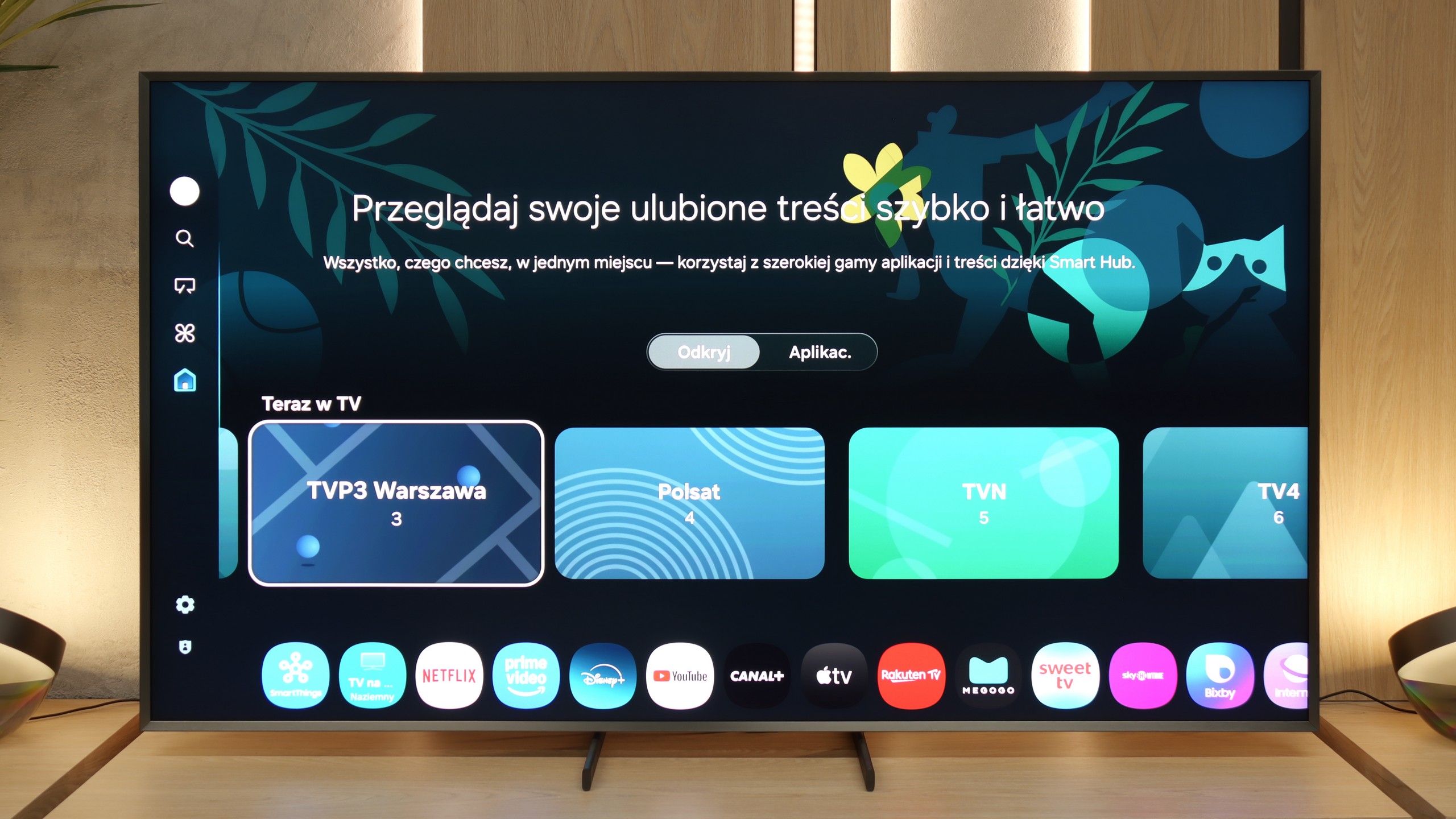
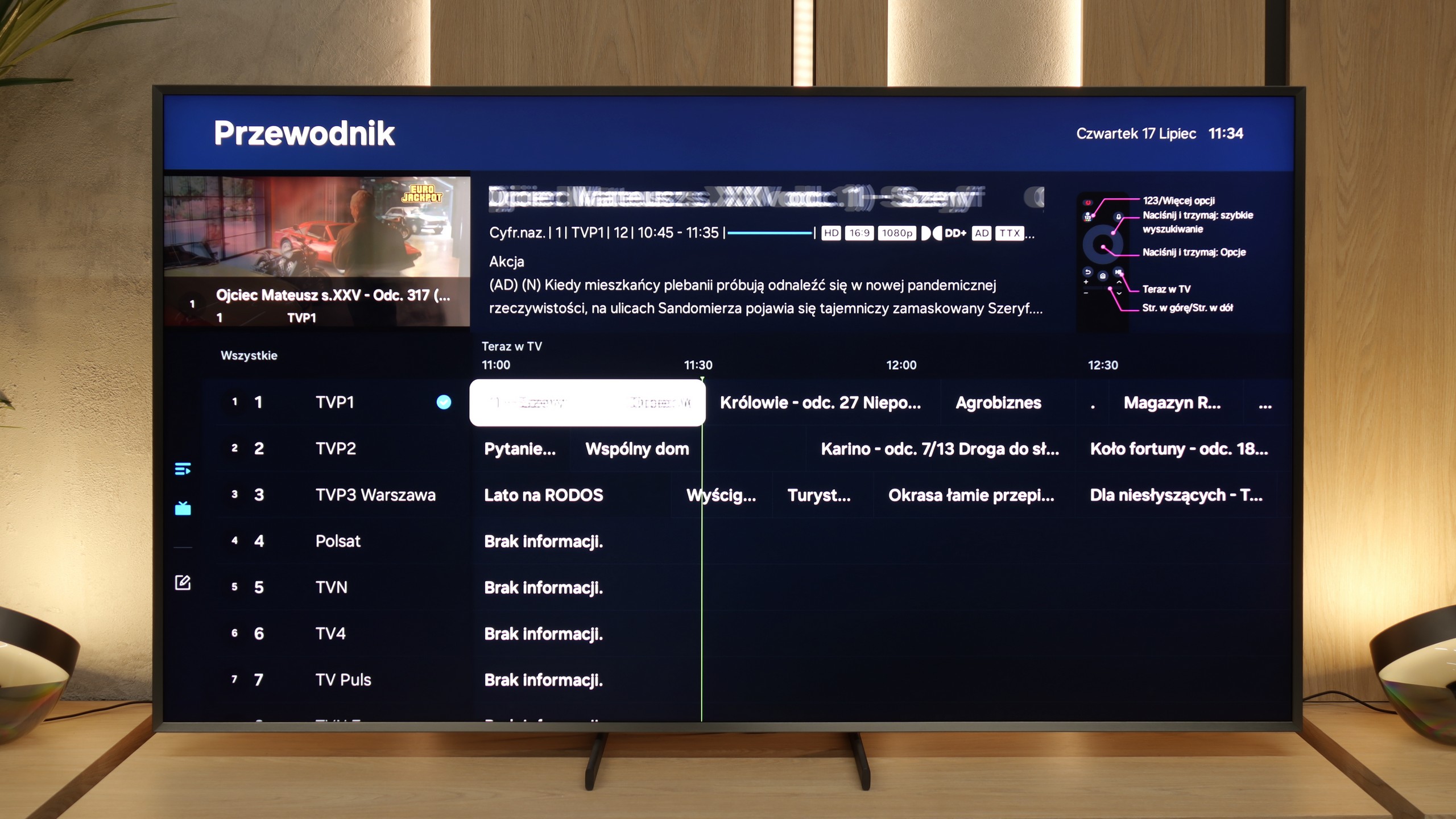
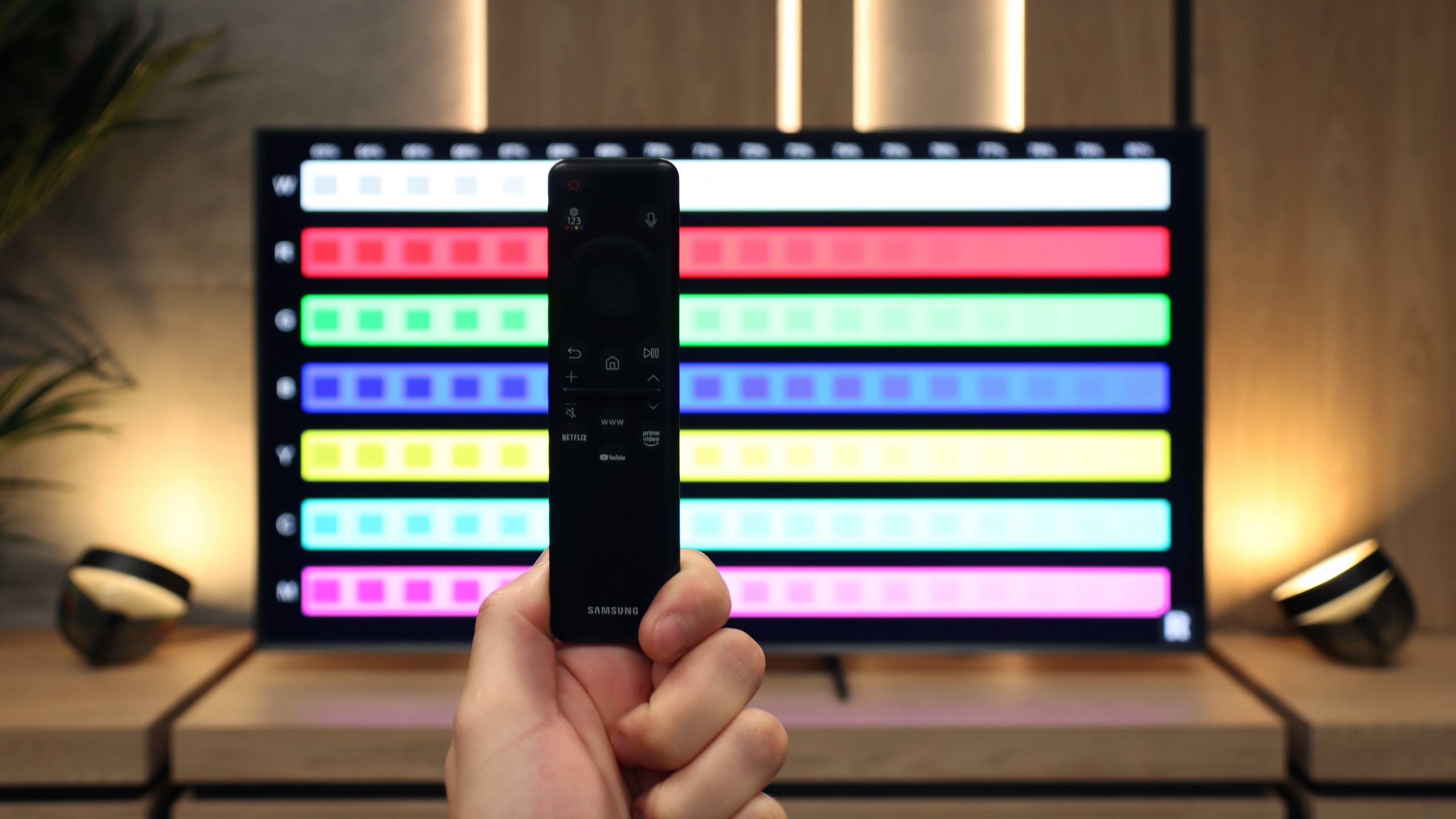
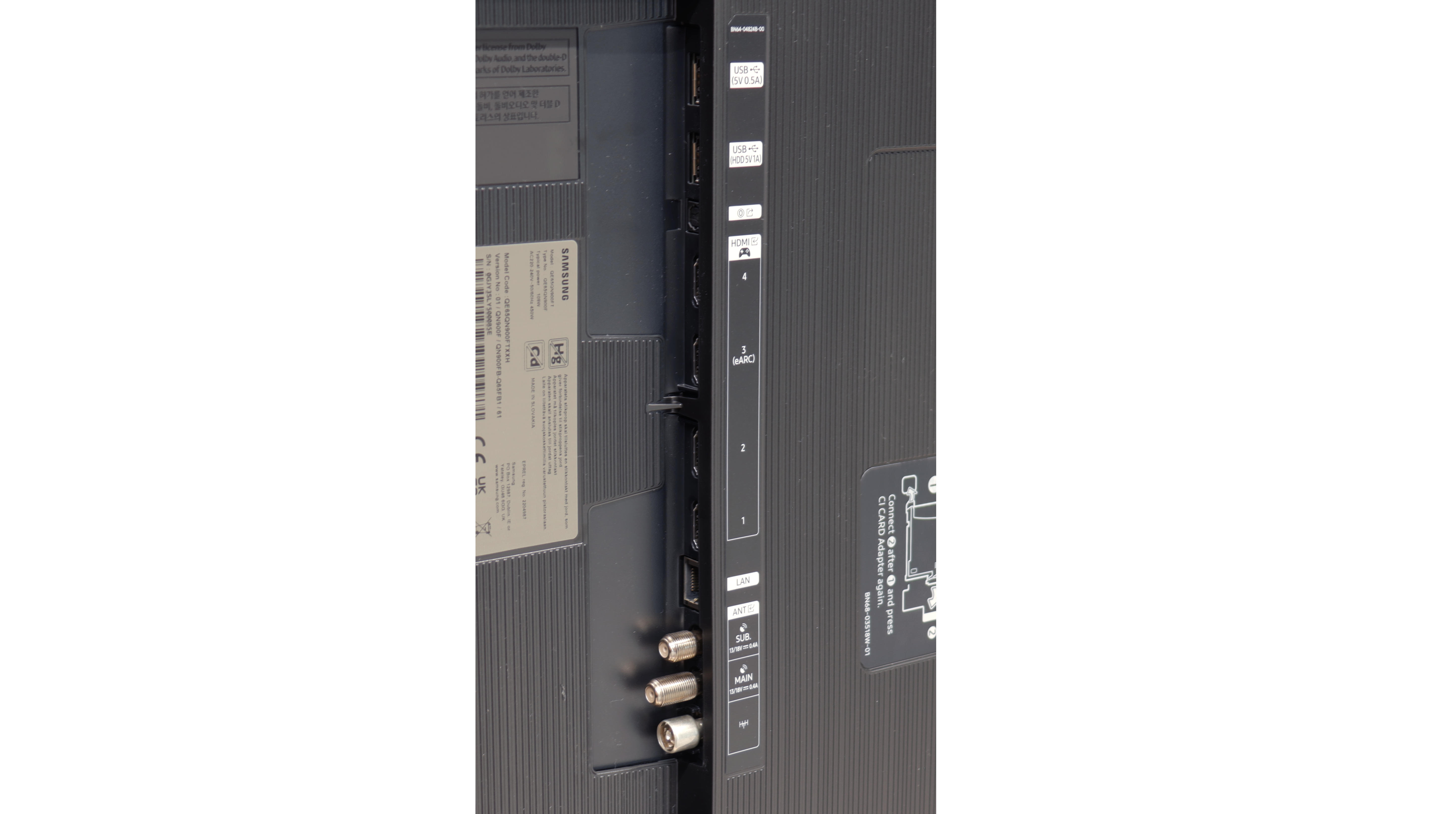
The Tizen system in Samsung televisions is characterised by simplicity and speed of operation. The central point of the interface is the "Smart Hub," which allows for quick access to the most important applications and recommended content, such as Netflix, YouTube, and Prime Video. Tizen also supports the Multi View function, allowing for simultaneous viewing of several image sources. Integration with AirPlay enables easy content sharing from Apple devices, and there is voice control in Polish. Users can control the television, search for content, and perform other operations using voice commands, which significantly facilitates the daily use of the device. One of the most distinctive elements of Samsung QN95D is the included Slim Fit camera, which offers functionality that goes beyond the standards of other models currently on the market. Thanks to the applied "POGO" connector, the camera can be easily connected directly to the television. It allows for video calls and personal training functions using the camera. This innovative approach opens up new possibilities for users in terms of interaction with the television.
It is also worth mentioning the solar remote control, which is an eco-friendly solution—it does not require battery replacement as it charges using solar energy. This remote is also universal, allowing control of other devices, such as the Canal+ decoder, without the need for additional remotes. This is a significant convenience that enhances user comfort. Features dedicated to users of traditional television include picture-in-picture (PIP), allowing for the simultaneous viewing of two programmes. However, the lack of recording functionality may be a disappointment, as this could be a drawback for some users.
Television Features
QN900F really has a lot to offer. In addition to standard connections and tuners, it also boasts many typical television features. There is teletext, a clear EPG, and even a PiP function, which is rare these days. The QN900F easily supports other devices using the solar remote included in the package, which somewhat compensates for the lack of recording from the built-in antenna tuners.
Smart TV
When it comes to smart features, Samsung, as always, provides plenty – there is a vast number of applications (though not all), and the Tizen on the QN900F ran very smoothly. It is also hard to find a better television for connecting external devices – AirPlay, Miracast, Chromecast – everything works flawlessly. A curiosity is the Art Gallery mode, which - similar to The Frame - allows you to display artworks on the turned-off screen. Thanks to its relatively thick, robust frame, the effect is quite impressive – on the wall, it looks like a digital painting and can certainly make an impression on someone. Therefore, the QN900F can be whimsically dubbed The Frame Super Extra Pro 😉
Playing files from USB
9.1/10
9.1/10
Supported photo formats:
Maximum photo resolution:

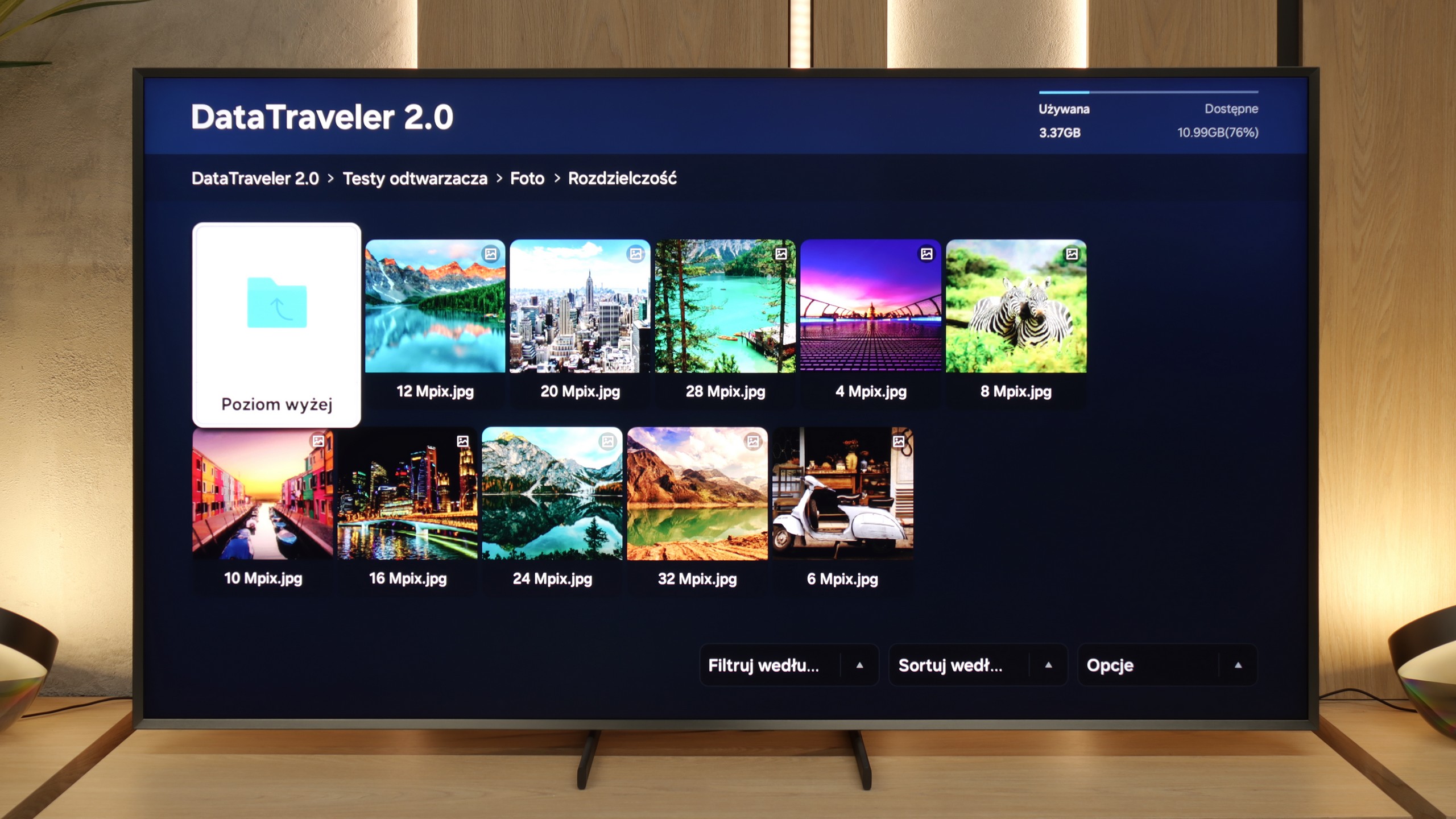
The built-in player in the Samsung QN95D television is undoubtedly one of its stronger points. It handles almost all video and audio file formats that we tested exceptionally well. The exception is the lack of support for Dolby Vision, which aligns with Samsung's policy, and less popular codecs. A significant advantage is the support for Polish characters in subtitles and the ability to customise font colours, which greatly improves the comfort of watching content with subtitles. A downside may be the limited support for photo formats – the television mainly supports JPEG, and there is a lack of support for more advanced formats such as PNG or Apple HEIC.
The built-in media player in the QN900F works really well. During testing, we did not notice any major problems with handling various audio and video formats – you can verify this yourself in our file listing. The only puzzling issue arose with subtitles – only those saved in .txt format worked for us, despite Samsung's information that the television should support significantly more extensions. What could be the reason for this? It's hard to say. It is possible that this is just a temporary bug that will be fixed in one of the upcoming updates.
Apps
9.1/10
8.7/10














































Sound
7/10
8.2/10
- Maximum volume--
- Dolby Digital Plus 7.1
- Dolby True HD 7.1
- Dolby Atmos in Dolby Digital Plus (JOC)
- Dolby Atmos in Dolby True HD
- DTS:X in DTS-HD MA
- DTS-HD Master Audio
The sound in Samsung QN95D is at a very good level thanks to the 4.2.2 system with a power of 70W. It provides clear, crisp audio, and the bass is well-balanced, which works well both for watching films and gaming. The support for Dolby Atmos adds a spatial effect, allowing for a fuller audio experience. However, there is a lack of support for DTS, which is a typical feature for Samsung TVs, but it may be a downside for those attached to that format. Overall, the sound performs very well and should meet the needs of most users.
The QN900F performs really well – as befits a premium television. The bass is quite strong, but slightly muted. We wouldn't compare it to top audio systems, but for built-in speakers, it does the job. The high tones are also a plus – quite clear and distinct, which is particularly useful when watching films with a lot of dialogue. Unfortunately, Samsung still does not support the DTS:X format in its televisions. This means that if we want to hear sound recorded in this standard, we need to connect an external home cinema through an amplifier – the television simply won't play it on its own.
